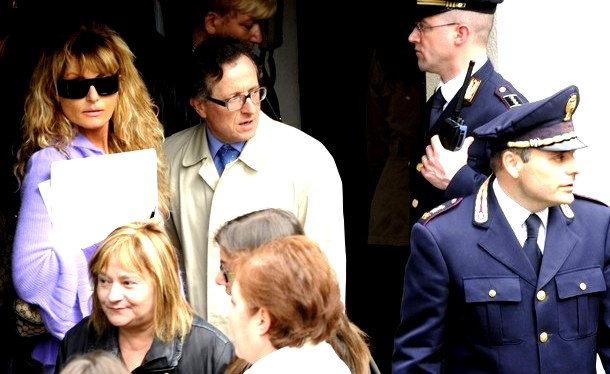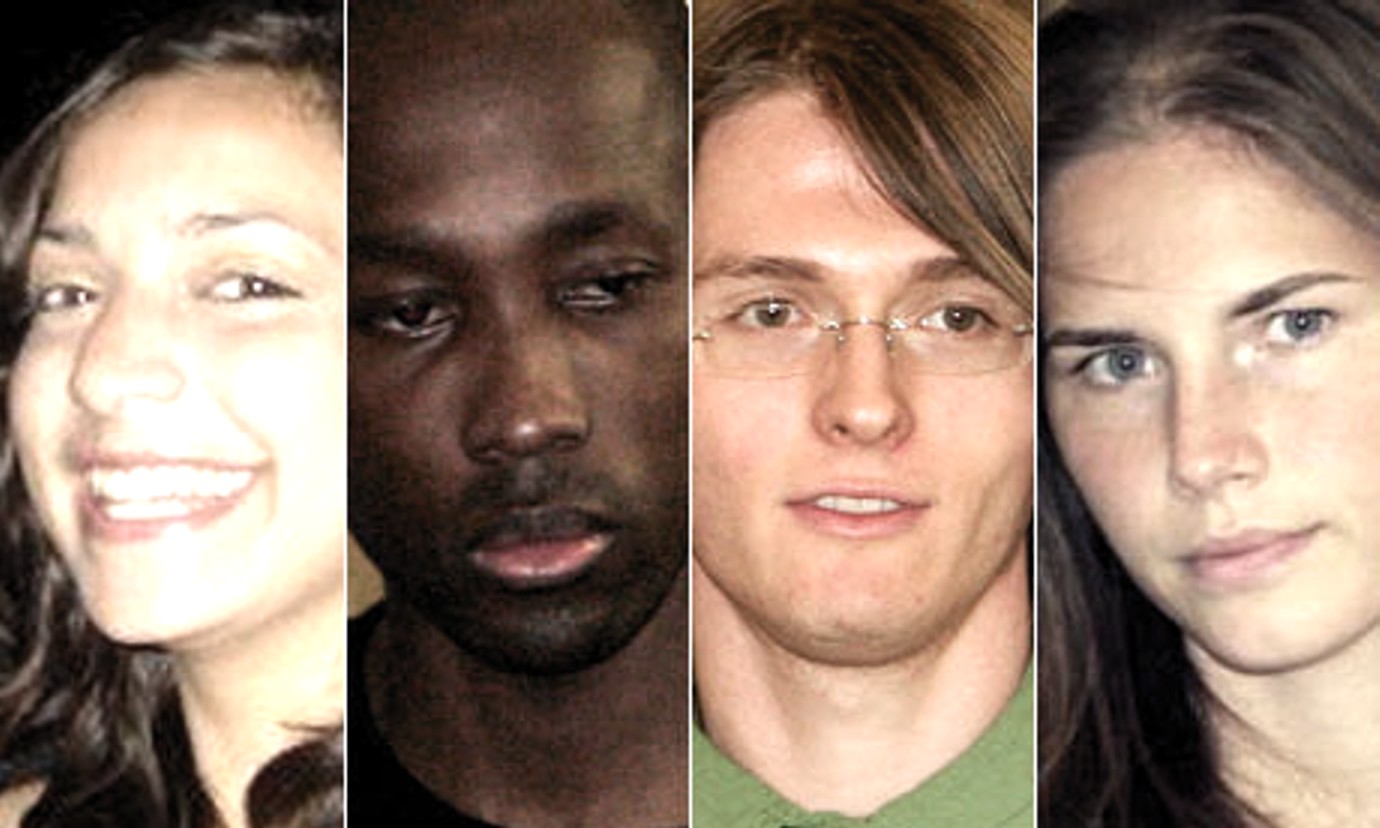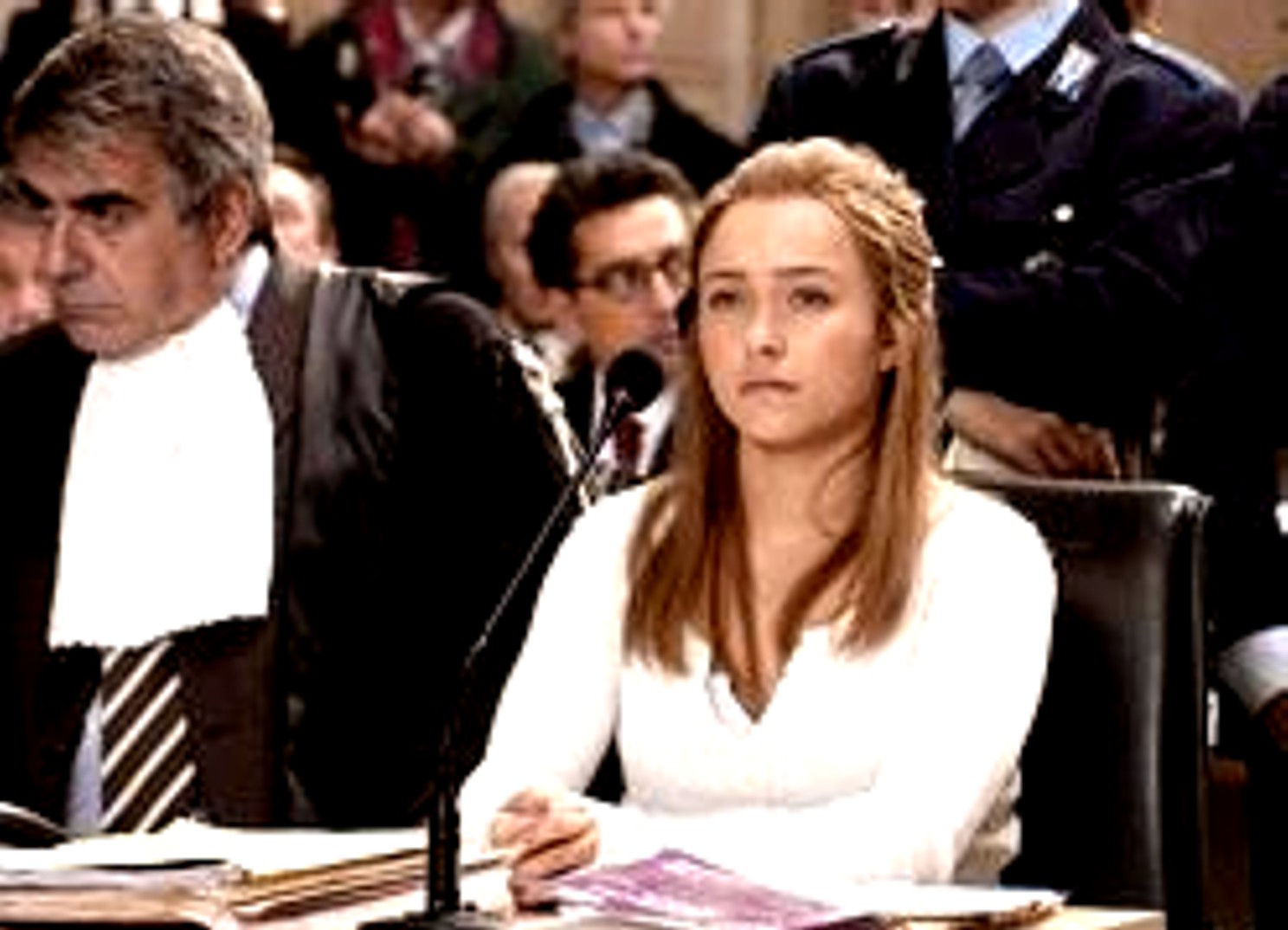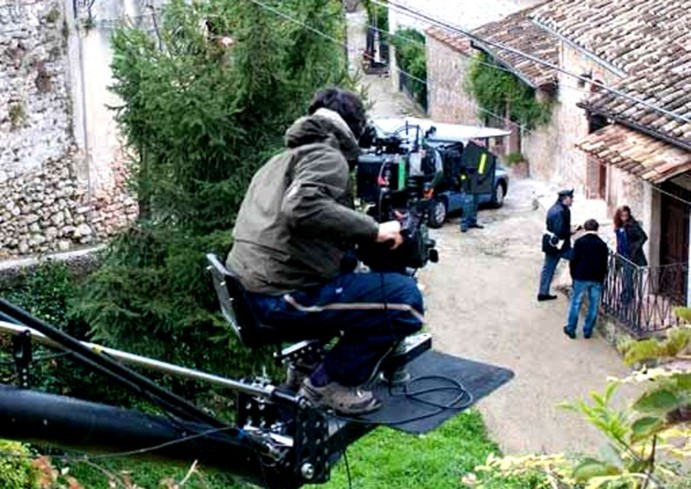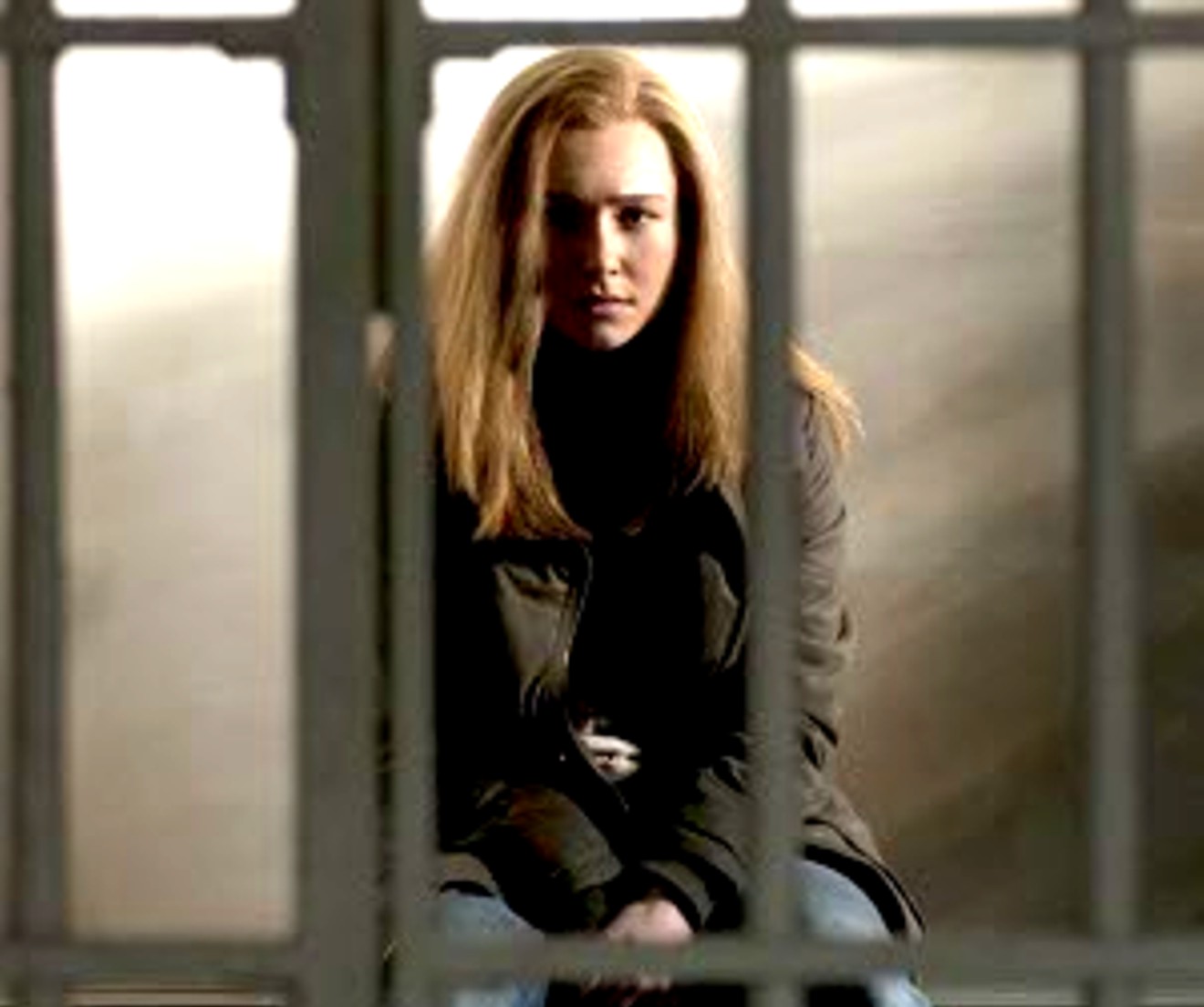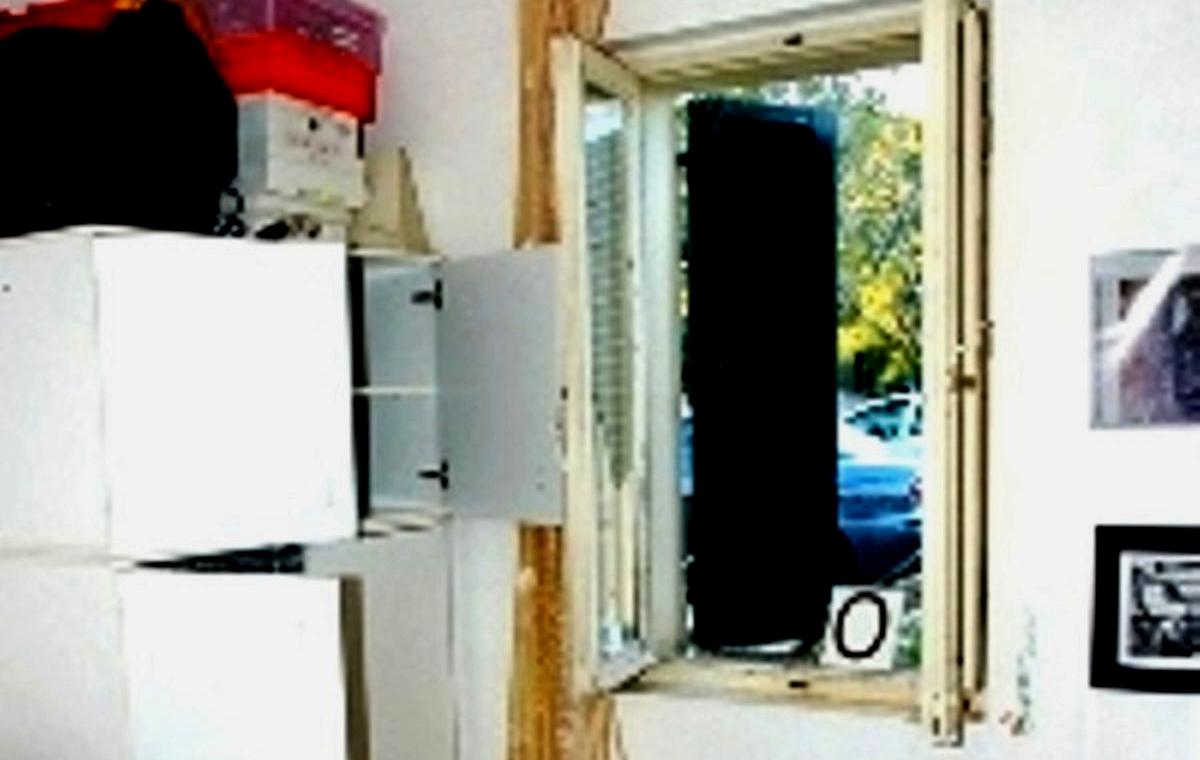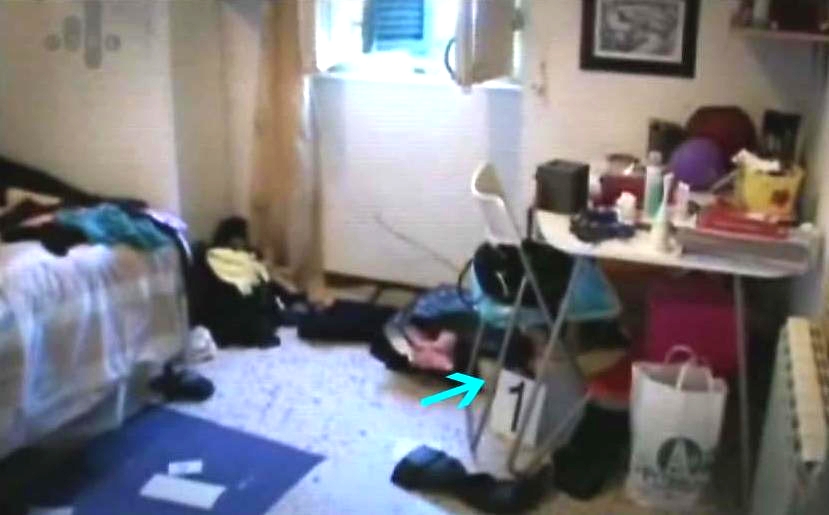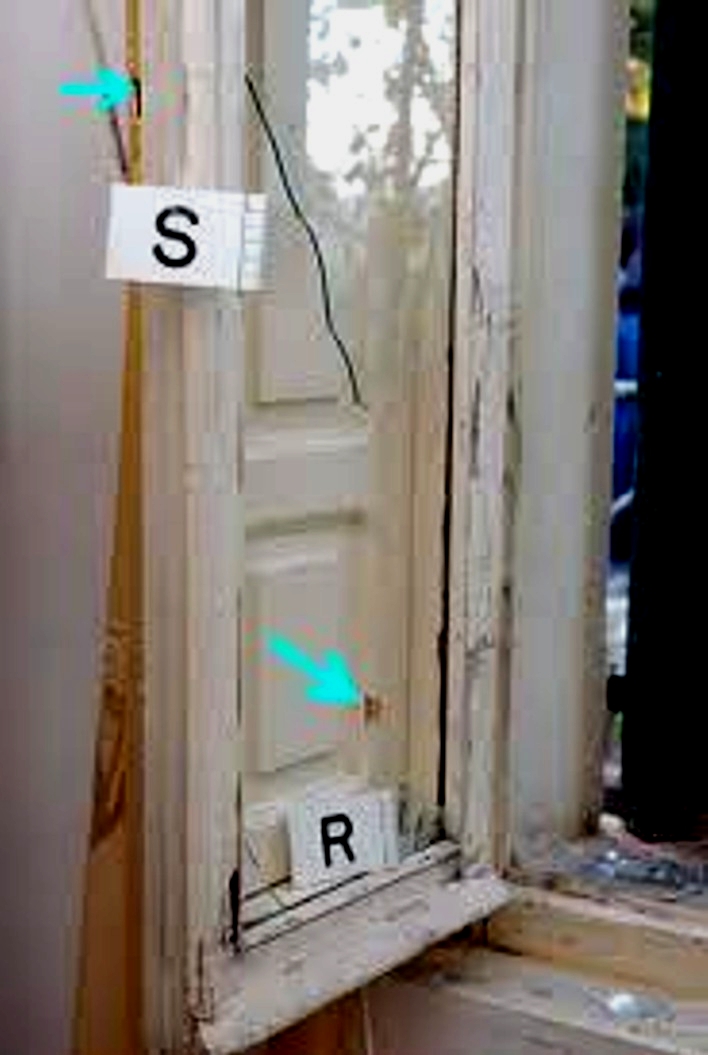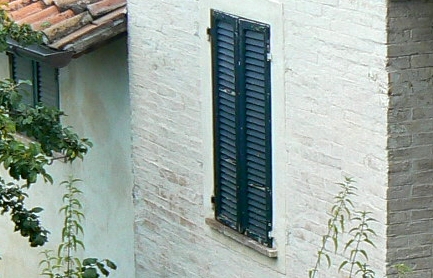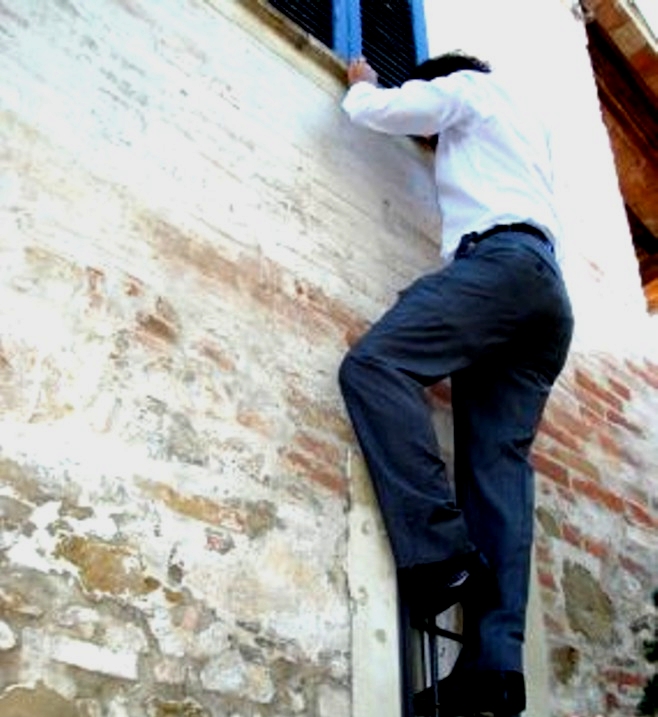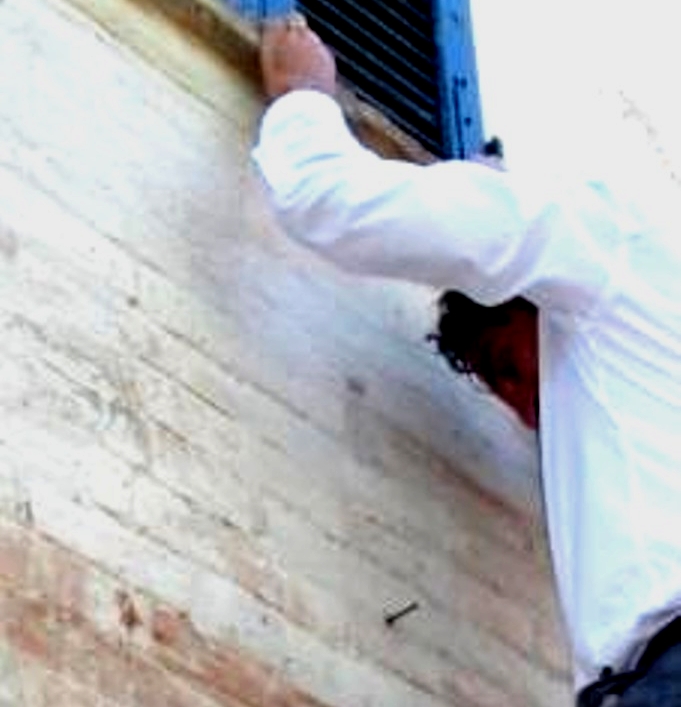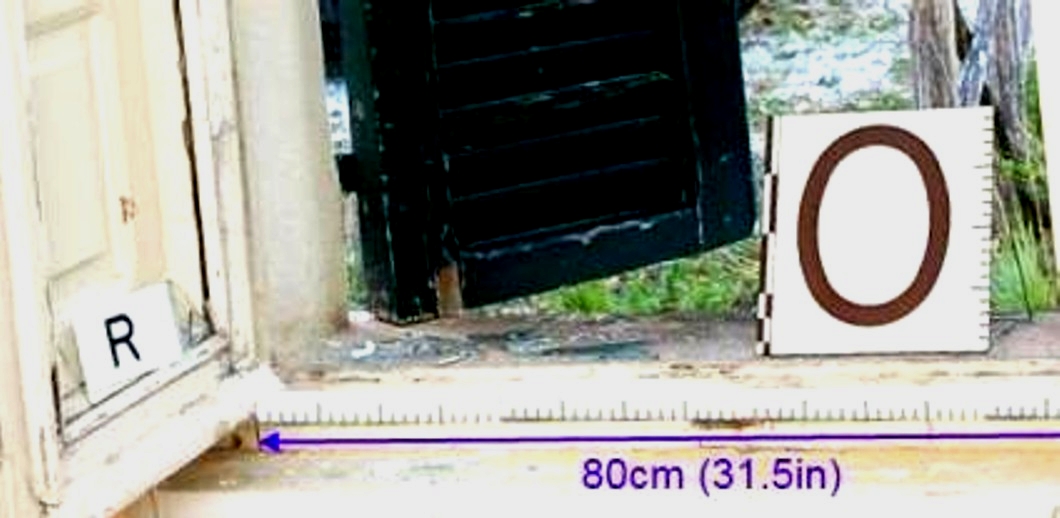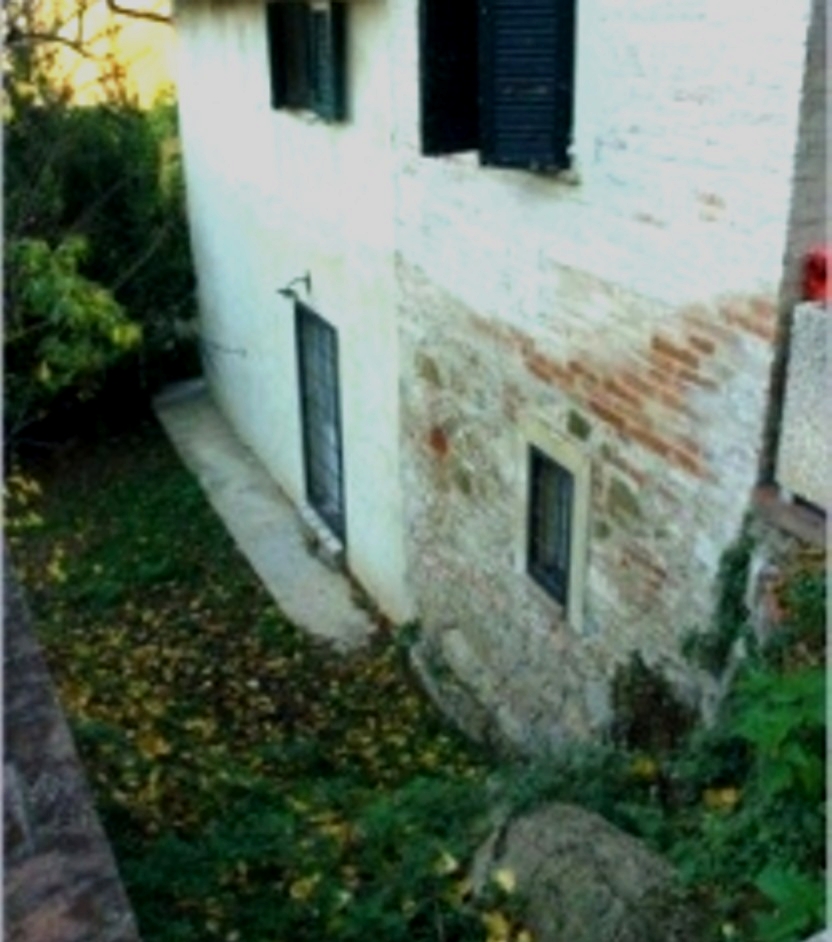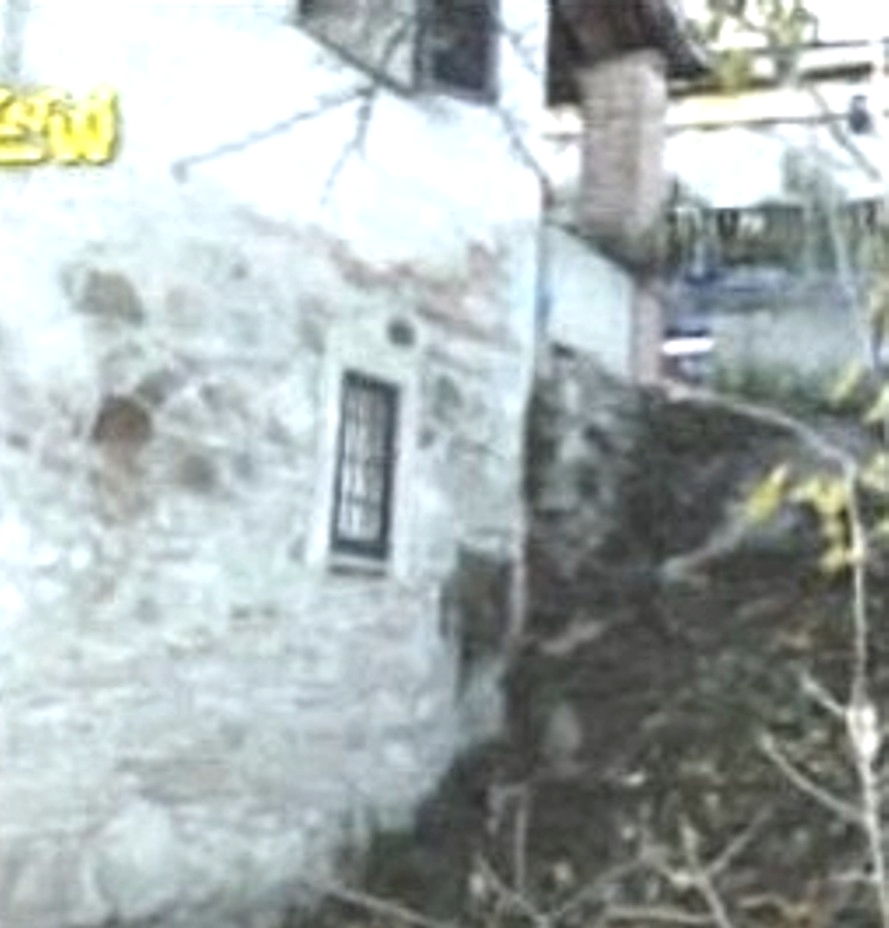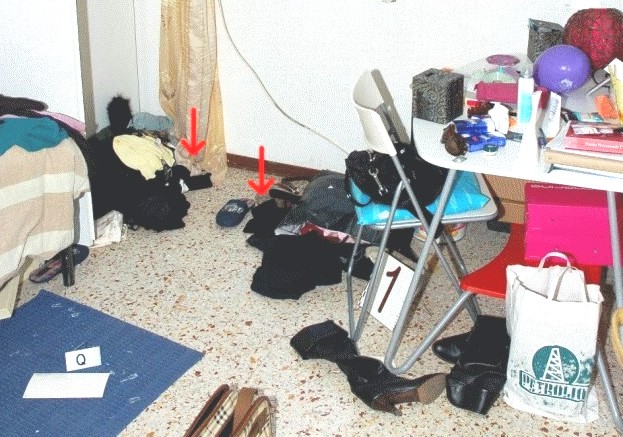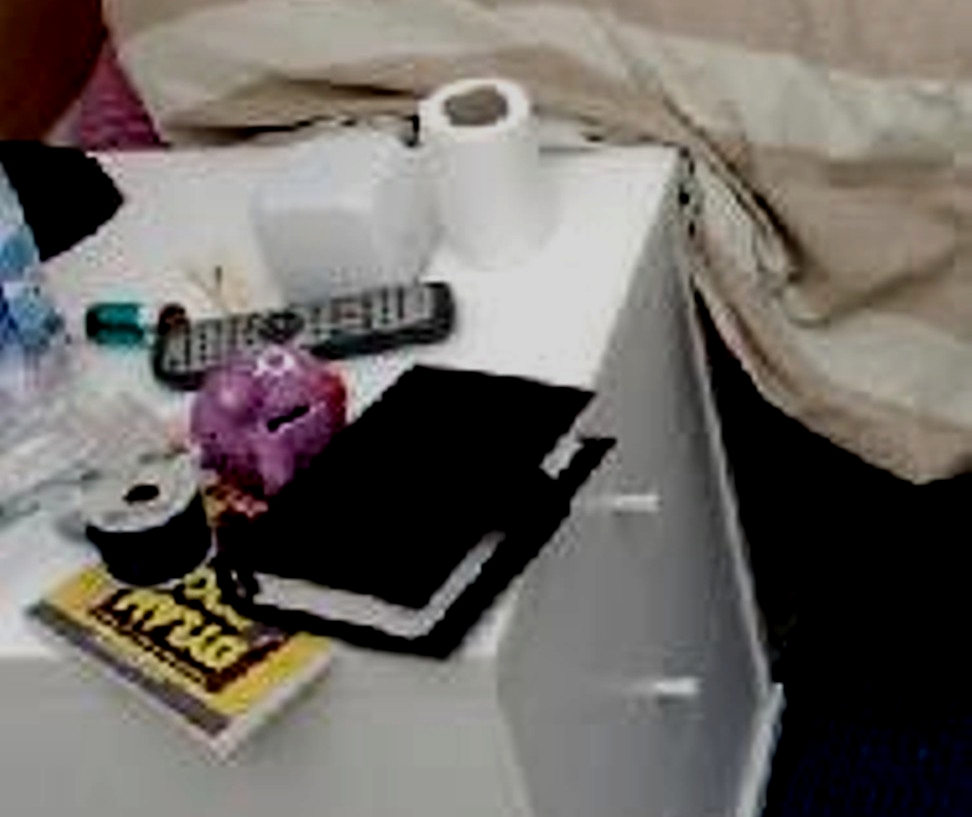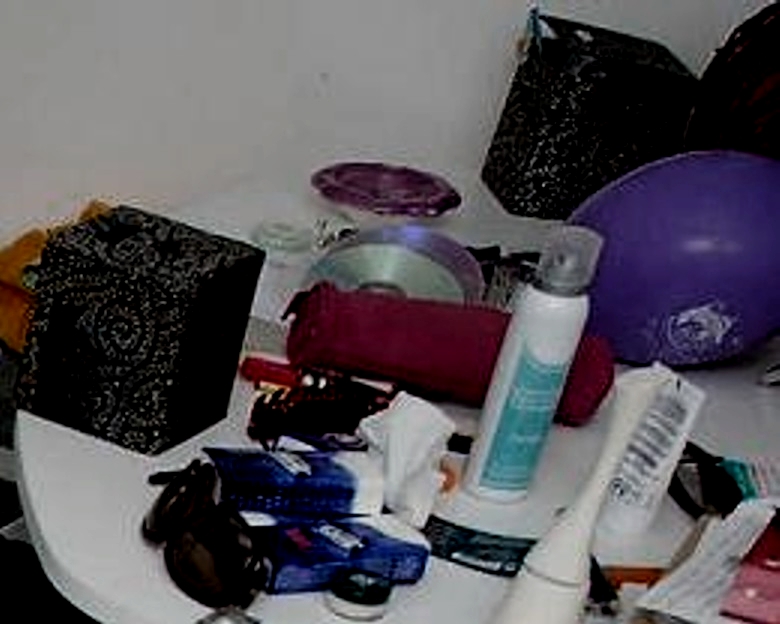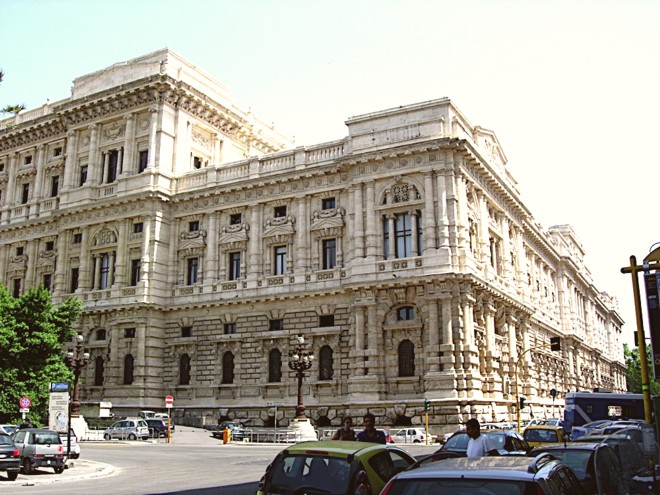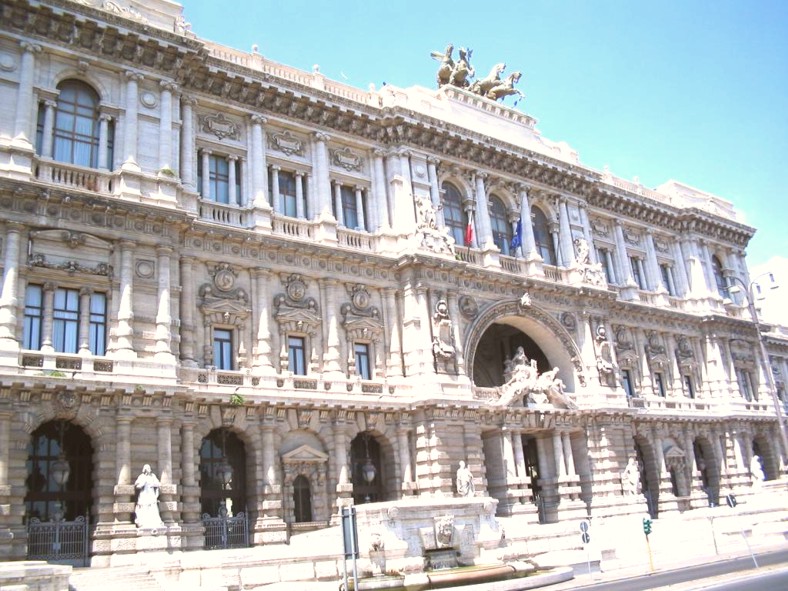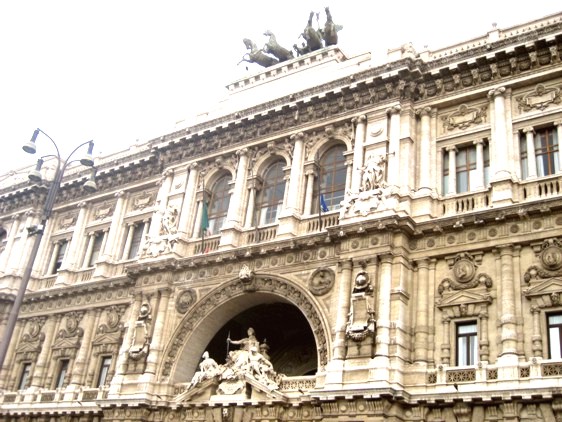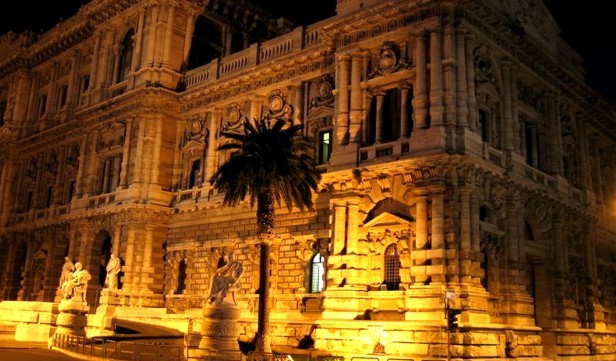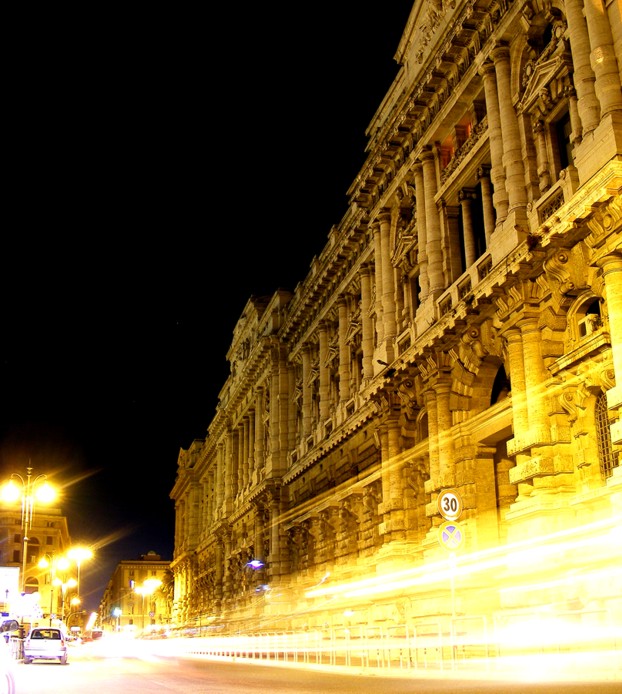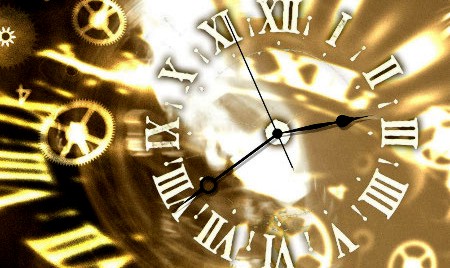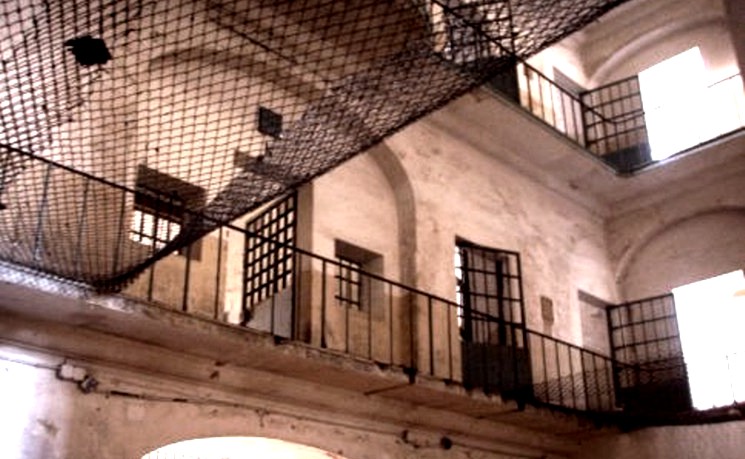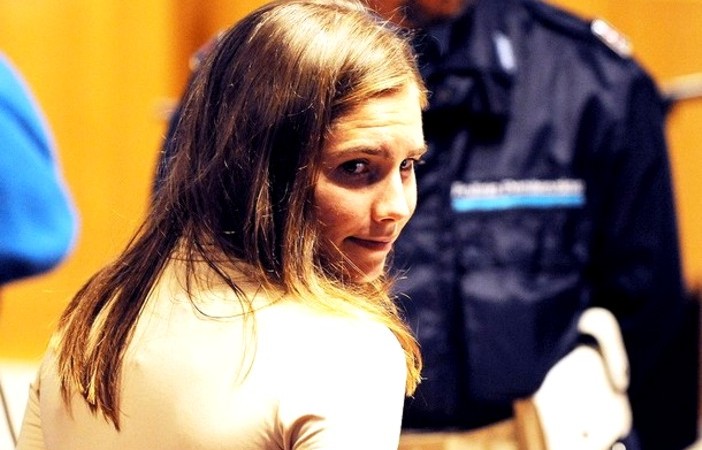
Category: Faked breakin
Sunday, June 19, 2011
The Massei Sentencing Report For Knox And Sollecito: Part 3 Of A Summary In 4 Parts
Posted by Skeptical Bystander
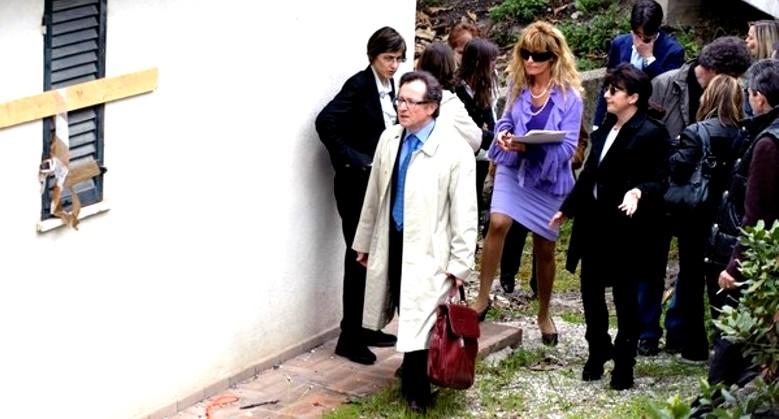
The full Massei Report can be found here. Continuing on with our summary:
7. Double DNA knife and bra strap
Exhibit 36: The double DNA Knife
Exhibit 36 is a 31 cm long knife with a 17 cm blade and a dark handle. It was seized from the kitchen cutlery drawer at Raffaele Sollecito’s home, located at 110 Corso Garibaldi in Perugia, on 6 November, 2007 when Chief Inspector Armando Finzi was ordered to perform a search of Sollecito’s residence. This exhibit is important because “Sample 36b” taken from a scratch on the knife blade yielded Meredith Kercher’s biological profile.
After putting on gloves and shoe coverings, Finzi and his team entered the home. They noted a strong smell of bleach. Opening the cutlery drawer, they saw a big, “extremely clean” knife. In Sollecito’s bedroom they found a second knife. The knives were bagged and sealed.[106]
Exhibit 36 was carried back to the police station, where it was placed in a box for shipping to the Polizia Scientifica in Rome. Dr. Stefanoni was the recipient of the box containing the knife in Rome. All parties testified that standard procedures were followed to avoid the risk of contamination.
On 4 November, 2007, Meredith’s roommates Filomena Romanelli, Laura Mezzetti, and Amanda Knox had been taken by the police to look at the knives in their kitchen at the apartment in Via della Pergola. Personnel from the Questura reported Amanda’s “severe and intense emotional crisis, unlike [the reaction of] the other two girls”.[292] This behavior was contrasted to Amanda’s behavior at Police headquarters two days earlier:
“This circumstance appears significant both in its own right and also when one considers that Amanda had never previously shown signs of any particular distress and emotional involvement (in the Police headquarters, on the afternoon of November 2, Meredith’s English girlfriends, Robyn Carmel and Amy Frost in particular, according to their declarations, had been surprised by the behaviour of Amanda, who did not show emotions).”[292]
Investigators’ attention was alerted to the Exhibit 36 knife because of Amanda’s inconsistent behavior. Later, police overheard a jail conversation between Knox and her parents on 17 November, when Knox said, “I am very, I am very worried about this thing with the knife ... because there is a knife of Raffaele’s ...”.[292]
Exhibit 36 thus became a central piece of trial evidence. The debate would subsequently be focused on two issues: The compatibility of the knife with the large stab wound in Meredith’s neck; and the reliability of the DNA analysis.
Considering the first of these points, although the knife blade is 17 cm long, the depth of the larger wound is just 8 cm . This “discrepancy” was the basis of defense efforts to discredit the knife as a murder weapon. The compatibility of the Exhibit 36 knife and the larger of Kercher’s wounds is addressed by Professor Bacci (see p. 121 of the Massei report). Professor Norelli maintains that “it is not said that a blade is always embedded (plunged into) the target right up to the handle; the blade may also go (in) only to a certain portion of its length, and not right up to its end”.[126]
It is noted that the movements of the victim may have played a part in determining the depth of the cuts. “If I insert a centimeter of the blade into the victim and the victim suddenly moves towards me, how much of the blade will be driven inside the body surface area is absolutely unpredictable and depends on the action of both”.[129] Alternatively, the blade of the knife might have met an obstacle. The cutting action is described on p. 146 and again starting on p. 152.
Defense witness Dr. Patumi disputed the compatibility of the wounds with said knife, arguing that a blade of 17 cm length could not have caused a cut 8 cm deep; see p. 156-157. However, the Court rejected “the thesis of the incompatibility of the most serious wound and the knife Exhibit 36”, holding this thesis to be “unacceptable” .[172]
Regarding the second point ““ that of the DNA analysis ““ Dr. Stefanoni was the responsible expert at the crime lab in Rome. Although no biological traces were visible to the naked eye on the face of knife blade, Dr. Stefanoni perceived scratches - “anomalies in the metal’ - on the blade when rotating the blade under strong lighting. The streaks were:
“... visible under good lighting by changing the angle at which the light hit the blade, since obviously the blade reflects light and thus creates shadows, making imperfections visible.”[196]
Sample 36b was taken from one of these points on the blade. The genetic profile of Meredith Kercher was identified from this sample. Stefanoni presented charts to the court, showing the DNA profile: she noted “that the peaks were a bit low, but that without doubt were still within the range that is considered useful for testing a specimen (page 108). Although of a much lower quantity of DNA, the profiles were nonetheless very present and, by making a comparison with Meredith’s profile, Dr. Torricelli reported that “šwe find all the alleles, and we find them to be equal to those obtained from the swab taken, from the sample taken from the wound. Therefore in this case too, without doubt”› -she continued- “šalthough we are confronted with a sample that contains very little DNA, it nonetheless contains the DNA of only one person and is therefore comparable to Meredith’s; with regard to this knife, I would say I have no doubt in interpreting it: specimen A with Amanda’s profile and specimen B with the profile, compatible with that of Meredith.”[231-32] However, the amount of DNA was small and it was all used up in order to run a single test.
The defense objected that it was impossible to evaluate whether the actual nature of Sample 36b specimen:
“.. when we have a small amount of DNA we talk about low copy number DNA, and that when this type of DNA is present, we are indeed able to carry out our amplification and obtain a profile, but we must remember that we may have lost one of the alleles, we may have an allelic imbalance ... it becomes very difficult to distinguish from a real allele, so that when working on ... small quantities of genetic material, it is necessary to be very cautious in interpreting the results.”[237]
To this point, Dr. Stefanoni argued that it is preferable “to know to whom a biological specimen is attributable, rather than ascertaining the nature of that specimen, without attributing it to anyone.”[288]
Furthermore, it was argued by the defense that the quantity of DNA was too low to be able to perform the tests and consider the results reliable. Given a low amount of DNA, the risk of contamination is high - particularly given the very numerous number of samples being analyzed.
The court rejected the possibility of contamination because no anomalies were ever identified in the Polizia Scientifica’s analytical process. The Prosecutor pointed out that all tests had been carried out in the presence of a lawyer/consultant for the defense - who had raised no objections during the testing. The possibility of contamination during the collection of evidence was rejected based on a detailed consideration of the collection process.
Thus, the DNA from Meredith which was found on that knife cannot be traced back to any contamination occurring in the house in which it was found, or to the method of acquisition of the knife on the part of Finzi, or even to the collection and dispatch methods used by Gubbiotti. In addition, as has been said, that such contamination could have been carried out by the laboratory is also ruled out.[266]
In addition, Dr. Stefanoni testified that she did have the biological profile of the defendants, but did not employ them while interpreting the electrophoresis diagrams. Nevertheless, the Massei report judges that:
“... the main criticisms advanced by the defense concerned precisely this very small DNA quantity, and it raised the question of the reliability of the result obtained.”[288]
To this central point, Dr. Stefanoni:
“Regarding the too low quantity of DNA, Dr. Stefanoni declared, as has been seen, that even in the case of a particularly scanty amount of material, the analysis and evaluation should be performed, and she added that, if the data that emerges is absolutely readable and interpretable and the correct laboratory practice was followed, the result is reliable and there is no reason to repeat the test.
“It does not follow ... that the data is unusable and unreliable as a consequence of a lack of repetition due to a lack of further quantities of DNA. It is necessary, instead, to take account of the data that emerges from such a specimen and to check for the ““ possible ““ presence of other elements, both circumstantial and inherent to the data itself that, despite the lack of repetition of the analysis, could allow an evaluation of the reliability of the analysis and of its outcome.”[289]
The court concluded that the biological profile that resulted from the 36B DNA analysis ...
“... gave a biological profile attributable to the person who was mortally wounded with that very knife: a result, therefore, that was entirely reasonable and consistent with the event; [it was] certainly not explainable as a mere coincidence, and it must be ruled out ““according to what has already been observed in this regard - that it could have originated from contamination or from the use of a suspect-centric method.”,[290] and that
“”¦. it should therefore be affirmed that the analysis of trace 36B, which detected the presence DNA attributable to Meredith, appears to be completely reliable.”[293]
Exhibit 165 (Bra clasp)
Exhibit 165 is a small piece of material with hooks from Meredith Kercher’s bra. The Polizia Scientifica discovered Raffaele Sollecito’s DNA on this so-called “bra clasp”.
Dr. Stefanoni and her team began evidence collection at via della Pergola 7 on November 2, 2007. Additional searches were conducted of Sollecito’s Audi A3, Sollecito’s flat at Corso Garibaldi 110 (November 13), Patrick Diya’s pub “Le Chic” (November 14), and Rudy Guede’s studio (November 20). There was a further search at via della Pergola 7 on December 18.
Meredith’s bra (missing its clasp) was collected on November 2, 2007, in the first search, along with other items (towels, sheets, toilet paper, underwear, etc.). The bra was found at the foot of the victim in poor condition: torn off of Meredith’s body with cuts at the back. The bra is Exhibit 59.
The missing bra clasp was one object of the December 18 search. The search process - including measures taken to ensure against contamination - is described in detail on pp. 204-06 of the Massei report. However, it is noted that the bra clasp was picked up about 1.5 meters away from its original position as seen in photographs taken on November 2-3.
Small blood drops were clearly visible on the bra clasp material. The bra clasp revealed a mixture of DNA belonging to the victim and to Sollecito. According to Dr. Stefanoni the quantity of DNA was not low.
On trace B, from the clasp, a mixed genetic profile was found: the victim plus Sollecito and that result was further confirmed by the Y profile of Raffaele Sollecito, also found on the hooks.[197]
The Polizia Scientifica’s mixed trace DNA analysis is described in detail in Massei on pp. 206-11.
The defense raised the issue of the Polizia Scientifica using a “suspect-centric”methodology that might bias the DNA analysis and its interpretation. Dr. Stefanoni’s remarks are summarized in Massei:
“With reference then to the DNA of Raffaele Sollecito and the fact that his profile was already present and available to her when she interpreted the collected samples, including the one relating to the hooks, she stated that the data was present as historical fact, but that she did not have it, have it available before her at the moment in which she was interpreting the technical data, nor was she otherwise consulting this biological profile.”[226]
Given the delay in collecting the bra clasp and the fact that the bra clasp had been moved on the floor of Meredith’s room, the essential question before the court is presented as follows:
“Was ... the DNA of Raffaele Sollecito, which, according to Dr. Stefanoni, was found on the bra clasp, a consequence of an act of Raffaele Sollecito carried out directly on the bra which Meredith was wearing on the night that she was killed, or on the contrary, could it have had a different origin, so that this DNA could have ended up on the bra clasp without Raffaele Sollecito having ever touched the bra directly, and its clasp in particular?”[266]
The court observes that Meredith’s door was closed and locked on the morning of November 2; that’s how Sollecito and Amanda testify to have found it and that’s how the Postal Police saw it when they arrived. When the door was finally broken down and opened:
Raffaele Sollecito remained at a distance, far enough—as has been said—that he could not even have been able to look into the room; furthermore, it does not appear that he entered the room at any later time; in fact, as has been seen, the contrary has been shown: once the door was broken down, everyone was ordered to leave the house and Raffaele Sollecito did not enter into the cottage again, much less into Meredith’s room.[268]
Therefore the court rejects this hypothesis for the “placing” of Sollecito’s DNA in Meredith’s room. Furthermore, there is no reasonable suggestion that Sollecito could have placed his DNA on Meredith’s bra clasp in the prior week after meeting Amanda for the first time. Sollecito’s DNA was only found in one other location in the house: on a cigarette stub, mixed with that of Amanda Knox.
8. The staged break-in
The Massei Report examined the evidence surrounding the broken window and disarray in Filomena Romanelli’s bedroom in order to determine whether a real break-in had occurred or the appearance of one had been staged.
When she first returned to the apartment, Romanelli had made a quick check of her room and ascertained that, even though it was in a complete mess with the left-side [as seen from inside the room] windowpane broken and a big rock on the floor, nothing was in fact missing.[31] The court noted that when Romanelli had left the house, on November 1, she said she had pulled the external shutters towards the interior of her room, although she did not think that she had actually closed them completely. Because they were old and the wood had swelled a bit, they rubbed on the windowsill so, to pull them towards the room, it was necessary to use some force. But, once they had been pulled in, they remained well closed by the pressure of the swelled wood against the windowsill.[48]
Based on Romanelli’s testimony, the court rejected the assumption made by a defense expert witness that the external shutters were left completely open. In fact they were not even completely open on the day following the murder, according to witnesses on November 2.[50]
The initial assumption was that the window had been broken with a rock thrown from the outside (and such a rock was indeed found in the room). However, to have broken the glass of the window without shattering the external shutters, it would have been first necessary for a burglar to open these shutters. The court considered whether some sort of instrument could have been used to open them from the outside, but noted the failure to find any suitable instrument and doubted what type of instrument could be used to this end. This led them to assume that the wall would have to be scaled a first time in order to open the external shutters, so that the burglar could then aim a rock at the window. [48-49]
He would then have had to return underneath the window for a second climb, and balance on his knees or feet on the outside part of the windowsill, while reaching through the broken glass to unlatch the window. The court noted that the window must necessarily have been latched since, otherwise, there would have been no need to throw a rock at all, but just to open the external shutters and climb inside. [49] The burglar would also need to rely on the fact that the external shutters themselves were not actually latched, and also that the internal wooden shutters had not been fastened (otherwise it would have been impossible to open them from the outside).[49]
The court decided that this scenario appears totally unlikely, given the effort involved: going twice underneath the window, going back to throw the stone and scaling the wall twice. Especially so, taking into account the uncertainty of success (having to count on the two favourable circumstances indicated above), with a repetition of movements and behaviours, all of which could easily be seen by anyone who happened to be passing by on the street or actually coming into the house.
Next, the court noted that the double climb necessary to reach the height of three and a half metres would surely have left some kind of trace or imprint on the wall, particularly at the points on the wall that the burglar would have used to support his feet, especially as the earth below the window, on that early November evening, was very wet.[50] In fact, investigators had examined both the wall and all of the vegetation underneath the window, and noted that there were no traces on the wall of earth, or grass, or any streaks at all, and none of the vegetation underneath the window appeared to have been trampled.[142] Furthermore, it was observed that a nail that was part-way up the wall, remained intact. The court deemed it very unlikely, given the position of that nail and its characteristics, that a climber would not cause it to fall or bend.[50]
The next fact to consider was that the pieces of glass from the broken pane were distributed in a homogeneous manner on the inside and outside parts of the windowsill, without any displacement being noted or any piece of glass being found on the ground underneath the window. A prosecution expert witness stated that this tends to exclude the possibility that the rock was thrown from outside the house. Also, a climber, in leaning his hands and then his feet or knees on the windowsill, would have caused at least some piece of glass to fall, and he would have been obliged to shift some pieces of glass in order to avoid being wounded by them. Instead, no piece of glass was found under the window, and no sign of any wound was seen on the pieces of glass found in the room. It can moreover be observed that the presence of many pieces of glass on the outside part of the windowsill increases the probability of finding some small pieces of glass on the ground underneath, since there seems to be no reason that so many pieces of glass would all stop just at the edge of the windowsill without any of them flying beyond the edge and falling down to the garden below.[51,52]
These inconsistencies in the break-in theory can, however, be explained if one supposes that the rock was thrown from the inside of the room, with the two external shutters pulled inwards so that they blocked the pieces of glass from falling to the ground below. Once the glass had been broken from inside, the rock was set down at some place in the room, and the external shutters were pushed towards the outside, being thus opened from within the room.[51]
A further indication that the ‘break-in’ was staged was deduced from photos of the scene, taken by investigators. The appearance is that the goal was to create obvious disorder in Romanelli’s room, but does not appear to be the result of true searching for the kind of valuable objects that might tempt a burglar. The drawers of the little dresser next to the bed were not even opened; the objects on the shelves appear not to have been touched at all; piles of clothes seem to have been thrown down from the closet but it does not seem that there was any serious search inside the closet, in which some clothes and some boxes remained in place without showing any signs of an actual search for valuable items that might have been there. It does not appear that the boxes on the table were opened in a search for valuable items. Indeed, no valuable item was taken, or even set aside to be taken, by the ‘burglar’.
Based on all this evidence, the court concluded that the disorder in Romanelli’s room and the breaking of the window pane constituted an artificial representation created in order to misdirect the investigations towards a person who, not having the key to the front door, was supposed to have entered through the previously broken window and then effected the violent acts on Meredith which caused her death.
Saturday, February 26, 2011
Very Hard Language Of Supreme Court In Rejecting Guede Appeal, Confirming Three Did It
Posted by Peter Quennell
The report of the Supreme Court of Cassation released on Thursday was foreshadowed in content in our post of 17 December:
Rudy Guede’s appeal is rejected on all ten grounds. His appeal grounds were ugly and dishonest and he has no further appeal. He will serve his 16 years, with maybe some time off, for being a savage willing party to the cruel stupid murder of Meredith.
Rudy Guede will go down in infamy for his sex crime against a defenseless victim, for being a party to a taunting torturing knife attack, for claiming Meredith invited him in for consensual sex, and for not calling for help for Meredith and maybe saving her life while it was still possible.
Cassation continues the fine Italian court tradition in this case of taking a firm and unblinking position, and for being utterly oblivious to the vile over-the-top campaign of Curt Knox, Edda Mellas and David Marriott which may now haunt Amanda Knox all of her life.
What really caught the Italian media’s attention and made this the second most widely reported development in the case after the Amanda Knox-Raffaele Sollecito verdict was the icy hard language, the pure contempt for the depraved pack attack, the total rejection of all Guede’s stories, including his oft-repeated and totally unbelievable claim that Meredith invited him in and wanted love-making, and the court’s conclusion once again that the evidence methodically described in the Micheli Report overwhelmingly proves that THREE perpetrators took part in the crime.
The Court of Cassation in this report made clear that Knox and Sollecito are not already formally nominated as the other two perpetrators and it does wait the referral of the outcome of the present appeal in Perugia. But unless the defense witnesses Alessi and Aviello can indeed convince Judge Hellman’s appeal court that Guede attacked Meredith with friends or that some other people entirely carried out the attack, there seems no way out for them.
The court also indicated that it considered the motive of the attack on Meredith to be frivolous, which is precisely what the prosecution claims in the current Perugia appeal as grounds for rejecting Massei’s mitigating circumstances, and for increasing Knox’s and Sollecito’s prison sentences to life terms.
This post of a month ago further explains Knox’s and Sollecito’s almost insurmountable problems.
The written report from Cassation on that December 2010 decision on Guede’s final appeal (due soon), plus Judge Micheli’s Sentencing Report for Rudy Guede of January 2009, plus all that associated evidence, now gets automatically ported by law straight into Knox’s and Sollecito’s appeal.
Judge Micheli took a hard line toward Rudy Guede, and he sentenced him to 30 years. He also remanded Knox and Sollecito to trial, and his report explains the basis for that remand.
Judge Micheli’s remorseless and tightly argued report (see summaries below) very comprehensively backed up his decisions. (Later reductions in sentence were automatic and they flowed from the terms of Guede’s short-form trial, and some controversial mitigating circumstances advanced by Massei for Knox and Sollecito.)
The prosecution’s appeal against the Knox and Sollecito sentences argues that the acceptance of mitigating circumstances by the Massei court should be thrown out, and that Knox and Sollecito should be subjected to a longer sentence. Remember that even in the case of Alessi’s wife, who was not even present when he beat the kidnapped baby to death, she received a sentence of 30 years.
So here is how it is stacking up:.
For the prosecution, four courts including the Supreme Court of Cassation have ruled that three people participated in the crime against Meredith, plus all of the evidence from both the Guede and Knox Sollecito trials now comes in, plus the prosecution is appealing for tougher sentences, which seems well justified based on precedents.
And for the defenses? Will they now feel they have no choice but to put Knox or Sollecito or Alessi or Aviello or for that matter Rudy Guede on the stand as a last-ditch manoeuvre?
Hard to see what further they have to lose.
Tuesday, February 22, 2011
Open Questions: An Experienced Trial Lawyer Recommends How To Zero In On the Truth
Posted by SomeAlibi
Welcome
If you’ve come to this website because of the Lifetime movie of Meredith Kercher and Amanda Knox, then welcome.
Like all of us who come to this case, you have one key question: did they do it? The movie you’ve just watched is equivocal on that matter and perhaps didn’t help you at all.
On the internet, you will find people who are passionate in their defence of Amanda Knox and Raffaele Sollecito and you will find people who are passionate in their support of the prosecution.
My own arrival
Placing my own cards on the table here: as a twenty-plus year practising trial lawyer, I am firmly a part of that latter camp. But it wasn’t always that way.
It was information ““ evidence ““ that changed my views. What became very clear to me, early on, was that very few people in the English-speaking world are aware of anywhere near all of the evidence in this case.
I had thought I had grasped the core of the case, but I did not. The case is deep and complex and like many criminal cases, the complete facts behind it have been only sketchily reported in the media. The movie you may have just watched only skirts the real reasons the jury convicted.
The unanimous jury
I am sure that we all agree that no jury, in any murder case, given the awesome responsibility of adjudicating on (young) people’s lives for a multi-decade period of imprisonment, condemns people lightly.
It should be a matter of logic that the evidence presented against the accused must have been deep and satisfied the 6 lay jurors and 2 judges on the case for them to pronounce that huge judgement. That doesn’t mean that there couldn’t be the possibility of a mistrial, but clearly the evidence presented must have been substantial.
In this, we’ve already hit the first problem. Some supporters of Amanda Knox and Raffaele Sollecito will tell you there’s no evidence against them.
This is patently silly. No jury ever convicts people and sends them to prison for 24 plus years without being quite convinced of the case against them. Miscarriages of justice do happen, but the idea that there is “no evidence” can be summarily dismissed.
The only question is whether the evidence is sufficient, true and accurate.
The voluminous evidence
So is the evidence enough to convict beyond a reasonable doubt? The six lay jurors and two professional judges thought so, clearly. What you realise, when you come to the facts of the case, is that the evidence is based not around a single key event but on multiple points.
It can be astonishing to realise that the case is based not only on DNA evidence but also on cellphone evidence and computer records and further yet on multiple conflicting and contradicting versions of what happened that night from the mouths of the accused, not to mention falsely accusing an innocent man of responsibility for murder causing his incarceration.
The wealth of evidence is actually extremely unusual. It goes way beyond the quite similar Scott Peterson case.
The Massei Sentencing Report
What is absolutely new to the English speaking legal world is that the reasoning for the conviction can be read in an extremely detailed 440+ page report online. Bilingual posters at the Perugia Murder File Forum many of whom who are also key posters at TJMK translated the entire document into English over several months last year.
It was my privilege to play an extremely small part in that work. People from four different continents with backgrounds in forensic science, law, academia and a host of other disciplines participated.
You can read an effective executive summary by clicking on the Massei Report link at top here and reading the conclusions from page 388 onwards:
The Knox PR campaign
If you are new to this case, you will likely be shocked how much evidence there is against the convicted parties. Amanda Knox’s family have spent over $1m and involved a professional PR agency called Gogerty Marriot to suggest otherwise in the English-speaking media.
You might wonder why an innocent person needs a million dollar PR campaign on their part. Make yourself a coffee and read the conclusions of the judge’s report. It will take you about 15 minutes. Up until you read this report, almost everything you watch, hear and read is PR spin and is quite deliberately positioned to make you believe there is no case.
When you complete it, I believe you will have a very different take. That 15 minutes could change your ideas about everything you thought you knew about the murder of Meredith Kercher.
Now for a quick tour of the evidence.
Some of the points of evidence
Consider as you read it what is your own possible explanation for each of the following:
- the fact that the wound pattern and the reconstruction of the attack, each presented at trial in extensive closed-court sessions, showed this absolutely had to be a pack attack;
- the DNA of Raffaele Sollecito on Meredith’s bra-clasp in her locked bedroom;
- the almost-entire naked footprint of Raffaele on a bathmat that in *no way* fits that of the other male in this case - Rudy Guede;
- the fact that Raffaele’s own father blew their alibi that they were together in Raffaele’s flat at the time of the killing with indisputable telephone records;
- the DNA of Meredith Kercher on the knife in Raffaele’s flat which Raffaele himself sought to explain as having been from accidentally “pricking” Meredith’s hand in his written diary despite the fact Meredith had never been to his flat (confirmed by Amanda Knox);
- the correlation of where Meredith’s phones were found to the location of Raffaele Sollecito and Rudy Guedes’s flats;
- the computer records which show that no-one was at Raffaele’s computer during the time of the murder despite him claiming he was using that computer;
- Amanda’s DNA mixed with Meredith Kercher’s in five different places just feet from Meredith’s body;
- the utterly inexplicable computer records the morning after the murder starting at 5.32 am and including multiple file creations and interactions thereafter all during a time that Raffaele and Amanda insist they were asleep until 10.30am;
- the separate witnesses who testified on oath that Amanda and Raffaele were at the square 40 metres from the girls’ cottage on the evening of the murder and the fact that Amanda was seen at a convenience store at 7.45am the next morning, again while she said she was in bed;
- the accusation of a completely innocent man by Amanda Knox again and again when under no pressure which she insisted on putting in writing;
- the fact of Knox’s claim that she was aggressively interrogated for days, although she did not even have the status of a witness, and signed every page of every typed record of her mild, mundane and quite limited questionings;
- the fact that during Knox’s very unconvincing performance on the witness stand in July 2009 she admitted she was treated well and was not abused;
- the fact that when Amanda Knox rang Meredith’s mobile telephones, ostensibly to check on the “missing” Meredith, she did so for just three seconds - registering the call but making no effort to allow the phone to be answered in the real world
- the knife-fetish of Raffaele Sollecito, and his formal disciplinary punishment for watching animal porn at his university so far from the wholesome image portrayed;
- the fact that claimed multi-year kick-boxer Raffaele apparently couldn’t break down a flimsy door to Meredith’s room when he and Amanda were at the flat the morning after the murder but the first people in the flat with the police who weren’t martial artists could;
- the extensive hard drug use of Sollecito as told on by Amanda Knox;
- the fact that Amanda knew details of the body and the wounds despite not being in line of sight of the body when it was discovered;
- the lies of Knox on the witness stand in July 2009 about how their drug intake that night (“one joint”) is totally contradicted by Sollecito’s own contemporaneous diary;
- the fact that after a late evening’s questioning, Knox wrote a 2,900 word email home which painstakingly details what she said happened that evening and the morning after that looks *highly* like someone committing to memory, at 3.30 in the morning, an extensive alibi;
- the fact that both Amanda and Raffaele both said they would give up smoking dope for life in their prison diaries despite having apparently nothing to regret;
- the fact that when Rudy Guede was arrested, Raffaele Sollecito didn’t celebrate the “true” perpetrator being arrested (which surely would have seen him released) but worried in his diary that a man whom he said he didn’t know would “make up strange things” about him despite him just being one person in a city of over 160,000 people;
- the fact that both an occupant of the cottage and the police instantly recognised the cottage had not been burgled but had been the subject of a staged break-in where glass was *on top* of apparently disturbed clothes;
- the fact that Knox and Sollecito have feuded quite publicly ever since November 2007 and have shown far more anger toward one another than either has ever shown toward Guede;
- the fact that Knox and Sollecito both suggested each other might have committed the crime and Sollecito TO THIS DATE does not agree Knox stayed in his flat all the night in question;
- the fact of the bizarre behaviour of both of them for days after the crime;
- the fact that cellphone records show Knox did not stay in Sollecito’s flat but had left the flat at a time which is completely coincidental with Guede’s corroborated presence near the girl’s flat earlier in the evening;
- the fact that Amanda Knox’s table lamp was found in the locked room of Meredith Kercher in a position that suggested it had been used to examine for fine details of the murder scene in a clean up;
- the unbelievable series of changing stories made up by the defendants after their versions became challenged;
- Knox’s inexplicable reaction to being shown the knife drawer at the girl’s cottage where she ended up physically shaking and hitting her head despite being joyful earlier at the police station.
In conclusion
This list is not exhaustive. It goes”¦ on”¦ and on”¦ and on”¦ And yet, those supporting Knox will tell you that’s all made up, all coincidental.
Really? Does the weight of all that evidence sound made up to you?
If so, it must be the most over-rigged criminal case in the history of crime. Unlikely beyond all and any reasonable doubt.
The judge’s report explains why the jury found the defendants guilty. I truly expect you will be astonished at the amount of evidence if all you’ve done is watched a film or read a few press reports.
For any questions thereafter, please join us and post them on truejustice.org or perugiamuderfile.org . You’ll find here a host of good people who are all working on a totally volunteer basis in memory of the only victim of this crime.
Meredith Susanna Cara Kercher. RIP.
Tuesday, February 01, 2011
Explaining The Massei Report: A Visual Guide To The Faked Break-In Via Filomena’s Window
Posted by pat az
1. Post Overview
Cross-posted from my own website on Meredith’s case at the kind invitation of TJMK.
The Massei Report on the trial and sentencing of Amanda Knox and Raffaele Sollecito looks into whether or not a break-in is supported by the evidence available in the room with the broken window.
It concludes that the broken window and room in disarray - Filomena’s bedroom - are an “artificial representation”, ie. that the break-in was faked. After seven pages of review of the evidence, the Massei Report states:
“the situation of disorder in Romanelli’s room and the breaking of the window pane constitute an artificial representation created in order to orient the investigations towards a person who, not having the key to the front door, was supposed to have entered through the previously broken window and then effected the violent acts on Meredith which caused her death.
What follows is a look at the comments in the Massei report compared with crime scene and other photos. All quotes are from the English translation prepared by unpaid volunteers at PerugiaMurderFile.org. The section on the scenes in the bedroom begins on page 47 and continues to page 55. Some sentences in the paragraphs below have been omitted for brevity, and can be read in full in the original.
2. Knox Finds The Scene
Then (Amanda) went into another room and noticed that the window had been broken and that there was glass inside. She told these things to her and the other girls present. Then she related that she had gone back to Raffaele’s house and had rung Filomena.
I)n one of the telephone calls to Romanelli, Amanda spoke of that smashed window and of the possibility that someone could have entered the house through the broken place; she said this also in the telephone call to 112 and in the first declarations to the Postal Police.
Also in the e-mail of November 4, 2007, sent by Amanda to 25 people in the US, she hypothesises that a burglar could have entered the house and says she looked around to see if anything was missing.
Filomena Romanelli, disturbed by this phone call, had rung Amanda back without receiving a reply and when, a little later, she had succeeded in speaking to Amanda, Amanda had told her that in her room (i.e., in Ms. Romanelli’s room) the windowpane was broken, everything was in a mess, and that she should come back home.
Filomena Romanelli had ascertained from a quick check of her room, even though (it was) in a complete mess with the windowpane broken, that nothing was missing.
It must be held that when Filomena Romanelli left the house in via della Pergola, she had pulled the [interior] shutters towards the interior of her room, although she did not think that she had actually closed them; furthermore, because they were old and the wood had swelled a bit, they rubbed on the windowsill; to pull them towards the room it was necessary to use some force (“they rubbed on the windowsill”); but in this way, once they had been pulled in, as Romanelli remembered doing, they remained well closed by the pressure of the swelled wood against the windowsill.
It cannot be assumed - as the Defence Consultant did - that the [interior] shutters were left completely open, since this contradicts the declarations of Romanelli, which appear to be detailed and entirely likely, considering that she was actually leaving for the holiday and had some things of value in her room; already she did not feel quite safe because window-frames were in wood without any grille.
Also, the circumstance of the [interior] shutters being wide open does not correspond to their position when they were found and described by witnesses on November 2, and photographed (cf. photo 11 already mentioned).
Now, for a rock to have been able to break the glass of the window without shattering the outside shutters, it would have been necessary to remove the obstacle of the shutters by opening them up.
Consequently, since the shutters had been pulled together and their rubbing put pressure on the windowsill on which they rested, it would have first been necessary to effect an operation with the specific goal of completely opening these shutters.
The failure to find any instrument suitable for making such an opening (one cannot even see what type of instrument could be used to this end) leads one to assume that the wall would have to have been scaled a first time in order to effect the complete opening of the shutters, in order to enable the burglar to aim at the window and smash it by throwing a large stone - the one found in Romanelli’s room.
He would then have to have returned underneath Romanelli’s window for the second climb, and through the broken glass, open the window (balanced on his knees or feet on the outside part of the windowsill), otherwise he would not have been able to pass his arm through the hole in the glass made by the stone) and reach up to the latch that fastened the window casements, necessarily latched since otherwise, if the casements had not been latched, it would not have been necessary to throw a rock at all, but just to open the shutters and climb inside.
The “climber” would also need to rely on the fact that the [interior] shutters were not actually latched, and also that the “scuri” ]blackout blind] had not been fastened to the window-frame to which the broken pane was attached; otherwise it would not have been possible to open them from the outside; nor would it have been possible, even breaking the glass, to make a hole giving access to the house, since if these inner panels had been closed, they would have continued to provide an adequate obstacle to the possibility of opening the window, in spite of the broken pane.
This scenario appears totally unlikely, given the effort involved (going twice underneath the window, going up to throw the stone, scaling the wall twice) and taking into account the uncertainty of success (having to count on the two favourable circumstances indicated above), with a repetition of movements and behaviours, all of which could easily be seen by anyone who happened to be passing by on the street or actually coming into the house.
But beyond these considerations, there are other elements which tend to exclude the possibility that a burglar could have entered the house through the window of Romanelli’s room.The double climb necessary to attain the height of three and a half metres would have left some kind of trace or imprint on the wall, especially on the points on the wall that the “climber” would have used to support his feet, all the more as both the witnesses Romanelli and Marco Zaroli gave statements indicating that the earth, on that early November evening, must have been very wet (..6) (p50)
In fact, there are no visible signs on the wall, and furthermore, it can be observed that the nail ““ this was noted by this Court of Assizes during the inspection ““ remained where it was: it seems very unlikely that the climber, given the position of that nail and its characteristics, visible in the photo 11, did not somehow “encounter” that nail and force it, inadvertently or by using it as a foothold, causing it to fall or at least bend it. (p50)
The next fact to consider is that the pieces of glass from the broken pane were distributed in a homogeneous manner on the inside and outside parts of the windowsill, without any displacement being noted or any piece of glass being found on the ground underneath the window.
This circumstance, as confirmed also by the consultant Pasquali, tends to exclude the possibility that the rock was thrown from outside the house to create access to the house through the window after the breaking of the pane. The climber, in leaning his hands and then his feet or knees on the windowsill, would have caused at least some piece of glass to fall, or at least would have been obliged to shift some pieces of glass in order to avoid being wounded by them.
Instead, no piece of glass was found under the window, and no sign of any wound was seen on the pieces of glass found in Romanelli’s room. It can moreover be observed that the presence of many pieces of glass on the outside part of the windowsill increases the probability of finding some small pieces of glass on the ground underneath, since there seems to be no reason that so many pieces of glass would all stop just at the edge of the windowsill without any of them flying beyond the edge and falling down to the garden below. (p51 & 52)
On this subject it is also useful to recall that at the hearing of April 23, 2009, the witness Gioia Brocci mentioned above declared that she had observed the exterior of the house, paying particular attention to the wall underneath the window with the broken pane, the window of the room then occupied by Filomena Romanelli.
She said: “We observed both the wall”¦underneath the window and all of the vegetation underneath the window, and we noted that there were no traces on the wall, no traces of earth, of grass, nothing, no streaks, nothing at all, and none [39] of the vegetation underneath the window appeared to have been trampled; nothing” (p. 142 declarations of Gioia Brocci). (51)
This situation, like all the other glaring inconsistencies, is adequately and satisfactorily explained if one supposes that the rock was thrown from the inside of the room, with the two shutters pulled inwards so that they blocked the pieces of glass from falling to the ground below. Once the glass had been broken from inside, the rock was set down at some place in the room, and the shutters were pushed towards the outside, being thus opened from within the room. (p51)
But the fact that all this was in fact just a simulation, a staging, can be deduced from further circumstances. From the photos taken by the personnel of the Questura (photos 47 to 54 and 65 to 66) one can perceive an activity which appears to have been performed with the goal of creating a situation of obvious disorder in Romanelli’s room, but does not appear to be the result of actual ransacking, true searching for the kind of valuable objects that might tempt a burglar.
The drawers of the little dresser next to the bed were not even opened (photo 51 and declarations of Battistelli who noted that Romanelli was the one who opened the drawers, having found them closed and with no sign of having been rifled: see p. 66 of Battistelli’s declarations, hearing of Feb. 6, 2009).
The objects on the shelves in photo 52 appear not to have been touched at all; piles of clothes seem to have been thrown down from the closet (photo 54) but it does not seem that there was any serious search in the closet, in which some clothes and some boxes remained in place without showing any signs of an actual search for valuable items that might have been there (photo 54).
It does not appear that the boxes on the table were opened (photo 65) in a search for valuable items. And indeed, no valuable item (cf. declarations of Romanelli) was taken, or even set aside to be taken, by the ““ at this point we can say phantom ““ burglar.
What has been explained up to now thus leads to the assertion that the situation of disorder in Romanelli’s room and the breaking of the window pane constitute an artificial representation created in order to orient the investigations towards a person who, not having the key to the front door, was supposed to have entered through the previously broken window and then effected the violent acts on Meredith which caused her death.
Footnotes
(...1) The Massei Report in English is readable and downloadable via the link at the top of this page.
(..2) The consultant for the defence actually assumed that this had been done; in his exhibit, he assumed that the shutters were not present in front of the window
(..3): “if the shutters were closed, he could not have passed through, that is obvious”, cf. declarations of the consultant for the defence, Sergeant Francesco Pasquali, p. 22 hearing July 3, 2009.
(..4): (the window in Romanelli’s room is located at a height of more than three and a half metres from the ground underneath, cf. photo 11 from the relevant dossier)
(..5):,which are the wooden panels [scuri=non-louvered shutters in interior of room] that usually constitute the outer side (or the inner, depending on the point of view) of the window [attached to the outer edge of the inner side of the window-frame]
Thursday, January 20, 2011
The New 80,000 Pound Gorilla In The Room Introduced By The Italian Supreme Court
Posted by Our Main Posters

[St Peter’s and the Vatican in background; Palace of Justice, large white building by river in left foreground]
What is the biggest headache for the defenses?
That their areas of appeal, already circumscribed by Judge Hellman, could all explode in their faces? The low-credibility witnesses Alessi and Aviello? The limited DNA retesting? The re-examination of the witness in the park who had no cause to make anything up?
Or that Rudy Guede gets totally ticked off by Alessi’s claims that Rudy Guede said he did it with one or two others, and so Guede tells the court all that REALLY happened?
No, it looks to us that the defenses’ biggest headache by far is that the court of final appeal in Rome (the Supreme Court of Cassation, which is superior to the Perugia appeals court and will hear the second and final appeal) has ALREADY accepted that Rudy Guede’s sentencing report of January 2009 holds up.
And that all three of them attacked Meredith.
The written report from Cassation on that December 2010 decision on Guede’s final appeal (due soon), plus Judge Micheli’s Sentencing Report for Rudy Guede of January 2009, plus all that associated evidence, now gets automatically ported by law straight into Knox’s and Sollecito’s appeal.
Judge Micheli took a hard line toward Rudy Guede, and he sentenced him to 30 years. He also remanded Knox and Sollecito to trial, and his report explains the basis for that remand.
Judge Micheli’s remorseless and tightly argued report (see summaries below) very comprehensively backed up his decisions. (Later reductions in sentence were automatic and they flowed from the terms of Guede’s short-form trial, and some controversial mitigating circumstances advanced by Massei for Knox and Sollecito.)
The prosecution’s appeal against the Knox and Sollecito sentences argues that the acceptance of mitigating circumstances by the Massei court should be thrown out, and that Knox and Sollecito should be subjected to a longer sentence. Remember that even in the case of Alessi’s wife, who was not even present when he beat the kidnapped baby to death, she received a sentence of 30 years.
So here is how it is stacking up:.
- For the prosecution, four courts including the Supreme Court of Cassation have ruled that three people participated in the crime against Meredith, plus all of the evidence from both the Guede and Knox Sollecito trials now comes in, plus the prosecution is appealing for tougher sentences, which seems well justified based on precedents.
- For the defenses, just those few areas the defenses want to challenge which have been allowed by Judge Hellman NONE of which are sure things.
Really not very much going for the defenses here. No wonder they already seem to be phoning it in.
Our meticulous summaries of the Micheli Report by main posters Brian S and Nicki were based on our own translation. A huge amount of work. They were posted nearly two years ago. Periodically we link to them in other posts or we point to them in an email.
Those who do read those posts fresh are often stunned at their sharpness, and for many or most it becomes case closed and the verdict of guilty is seen as a fair one.
We think those posts on Micheli are so key to a correct grasp of Knox’s and Sollecito’s appeal prospects that they should now be reposted in full.
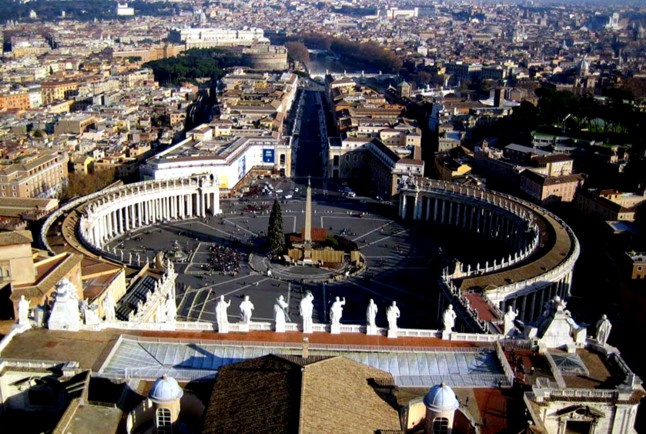
[St Peter’s and the Vatican in foreground; Palace of Justice, large white building in left background]
Understanding Micheli #1: Why He Rejected All Rudy Guede’s Explanations As Fiction
By Brian S
Judge Micheli has had two very important roles. He presided over Rudy Guede’s trial and sentencing, and he presided over the final hearing that committed Raffaele Sollecito and Amanda Knox to trial.
A week ago, just within the three-month deadline, Judge Micheli made public the 106-page report that explains the thinking behind both actions. This is a public document, and in the enviable Italian legitimizing process, the public is encouraged to get and read the report and to understand the full rationales. Excellent analyses have already appeared in Italian in Italy, but no English-speaking sources on the facts of the case have either put the report into English or published more than the most superficial analysis.
These posts will examine several very key areas of the report so that we too may choose whether to buy into the rationales. The translations into English here were by native-Italian speakers and fellow posters Nicki and Catnip. The next post will explain why Micheli ruled out the Lone Wolf Theory, and why he concluded that Knox and Sollecito appeared to be implicated in Meredith’s murder and should therefore be sent to trial.
Judge Micheli maintained that from the moment Meredith’s body was discovered until his arrest in Germany on November 19th, Rudy Guede was in a position to compile a version of his involvement in events at the cottage which would minimise his reponsibilities and point the finger of guilt elsewhere.
He was able to follow the course of the investigation in newspapers and on the internet. He would know of the arrests of Amanda, Raffaele and Patrick. He would know that the investigators had found biological evidence which would sooner or later connect him to the murder, and he would know of other discoveries and evidence which had been publicised in the media.
His story as told in Germany was compiled with all the knowledge about the crime and investigation he would have sought out. On his return to Italy in December he was interviewed by the investigating authorities and gave version 2. He was interviewed again in March which resulted in version 3, and later still made a spontaneous statement to change one or two facts including the admission that the trainer footprint in Meredith’s room could be his. Judge Micheli said:
- Analyzing the narratives of the accused…he is not credible, as I will explain, because his version is (1) unreliable, and (2) continuously varying, whether on basic points or in minor details and outline.
Micheli then examined the details of Rudy’s claimed meeting with Meredith which resulted in his invitation to the cottage on the evening of November 1st.
He noted there were substantial differences between his versions of December and March, particularly with regard to the location of his meeting with Meredith on the night of Halloween and his movements in the early evening of November 1st.
He considered it likely that Rudy had made these changes as he became aware of evidence which contradicted his December version. Notably, in December Rudy claimed to have had his meeting with Meredith which resulted in her invite at a Halloween party given by Spanish students.
By March it was well known that Meredith had spent her entire Halloween in the company of friends, first in the Merlin pub before they later moved on to Domus disco. In March Rudy changed the location of his meeting with her from the Spanish party to Domus, which by chance Rudy had also attended following the party. However, neither Meredith’s friends who were continuously in her company nor those who accompanied Rudy to the Domus witnessed any meeting between the two. Judge Micheli commented:
- On 26 March 2008, instead, Rudy explained to the Prosecution, drawing a picture, that the group invited to the Spaniards’ house actually moved wholus-bolus to the “Domus” club, but it was right in that nightclub that he met Kercher, and not before; offering up a tour-guide description from the chair, saying, “there’s a bar for the drinks and then there’s a room, there’s an arch and a room. I walking [sic] around there, and that’s where I met Meredith”. On the facts of the meeting and the subject of the conversation, he elaborated: “I started talking to Meredith “¦talking anyway I gave her a kiss.. after which I told her how much I liked her and asked her if the next day, in all the confusion anyway, if we were going to meet the next day and she said yes (”¦), we met in the evening around half eight, like that.
While not intending to explore the question, basically irrelevant, of whether the pair had agreed to a more or less specific time (his confirmation of the suggestion of 8.30 pm in both verbal statements however allows the inference that according to Guede they had an appointment), the patent contradiction between the two versions jumps out. One context, of a room between two bathrooms, in an apartment, is completely different to that of a drinks-bar and an arch, in a pub; one might concede, perhaps, the possibility of forgetting which place it was where they last bumped into a friend, but hardly the first time there was a kiss with a girl towards whom one was attracted.
With regard to his movements in the early evening of November 1st, Rudy’s friend Alex failed to corroborate Rudy’s December claim to have visited his flat. He said he didn’t see Rudy either before or after his meeting with Meredith at her cottage.
In March, Rudy changed his story and claimed to have risen at 6pm(following the all-nighter at Domus) before wandering around town for an hour or so. He then said he went to Meredith’s cottage but received no answer so he carried on to Piazza Grimana in the hope he might see people he knew. He thought he arrived in the Piazza at around 7:30pm. He claimed that some time later he left Piazza Grimana and called at the Kebab shop before returning to Meredith’s cottage and arriving some time between 8:30 and 9:00pm.
He said he then waited until her arrival some time just after 9:00pm. It was noted that in both his December and March versions Rudy said he had arranged to meet Meredith at 8:30pm. Micheli noted that this didn’t sit well with another arrangement Rudy had made to meet Carlos (from the Spanish party) between 9:00 and 10:00pm.
Micheli said that neither version of Rudy’s movements could be treated as true because he changed his story to fit facts as they became known and there was absolutely no corroborating witness evidence.
Rudy claimed two situations evolved following his entry with Meredith into the apparently empty cottage:
Whilst he was having a drink of fruit juice from the fridge, he claims Meredith found that 300 euros (her rent money) was missing from her bedside cabinet. Meredith was naturally upset by this discovery and straight away blamed “druggy Amanda”. Rudy said they both checked Amanda’s room to see if the money was there. However, it couldn’t be found and Rudy sought to console her.
He says that this consolation developed into an amorous encounter which proceeded to the stage where “Meredith asked him” if he had a condom. He told he didn’t and since she didn’t either they stopped their lovemaking.
Judge Micheli had a real problem with this story as told by Guede. He found it unlikely that Meredith would be interested in lovemaking so soon following the discovery that her money was missing. He found it unlikely that it was Meredith who was leading the way in this amorous encounter as Rudy was suggesting with his claim that it was “Meredith who asked him” if he had a condom.
Surely, Micheli reasoned, if Rudy was hoping to indulge in a sexual encounter with Meredith following the previous night’s flirting, he would, as any young man of his age, ensure that he arrived with a condom in anticipation of the hoped for liason. But even if he didn’t, and it was true that events had reached the stage where Meredith asked him, then surely given his negative response, Meredith would have again gone into Amanda’s room where, as she had told her friends, condoms were kept by her flat mate. Judge Micheli simply didn’t believe that if they had got to the stage of lovemaking described by Rudy, and following his negative response to her question, they just “STOPPED”. Meredith would have known she had a probable solution just metres away.
Rudy claimed he then told Meredith he had an upset stomach because of the kebab he had eaten earlier. She directed him to the bathroom through the kitchen.
Rudy put on his i-pod and headphones as he claimed was his habit when using the toilet. In his December version Rudy said the music was so loud he heard the doorbell ring but he made no reference to hearing any conversation. A perfect excuse, Judge Micheli says, for not hearing the disturbance or detail of Meredith’s murder. However, in his March version he claims he heard Amanda’s voice in conversation with Meredith. When Rudy did eventually emerge from the bathroom he says he saw a strange man with a knife and then a prone Meredith. Micheli commented:
- ...it is necessary to take as given that, in this case, Kercher did not find anything better to do than to suddenly cross from one moment of tenderness and passion with him to a violent argument with someone else who arrived at that place exactly at the moment in which Rudy was relieving himself in the bathroom. In any case, and above all, that which could have been a surprise to the killers, that is to say his presence in the house, was, on the other hand, certainly not put into dispute:
Meredith, unlike the attackers, knew full well that in the toilet there was a person who she herself allowed in, so for this reason, in the face of someone who had started raising their voice, then holding her by the arms and ending with brandishing a knife and throwing her to the floor, why would she not have reprimanded/reproached/admonished him immediately saying that there was someone in the house who could help her?
“¦Meredith didn’t shout out loudly for Rudy to come and help
“¦There was a progression of violence
“¦The victim sought to fight back
If it is reasonable to think that a lady living 70 metres away could hear only the last and most desperate cry of the girl ““ it’s difficult to admit that Guede’s earphones, at 4-5 metres, would stop him hearing other cries, or the preceding sounds.
Micheli was also mystified as to why Amanda (named in Rudy’s March version) would ring the doorbell. Why wouldn’t she let herself in using her own key? He supposed it was possible Meredith had left her own key in the door which prevented Amanda from using hers, but the girls all knew the lock was broken and they were careful not to leave their own key in the door. Perhaps, Meredith wanted some extra security/privacy against someone returning and had left her key in the lock on purpose. Maybe Amanda was carrying something heavy and her hands weren’t free. Or, maybe, Rudy was just trapped by his December story of the doorbell when he didn’t name anybody and an anonymous ring on the doorbell was plausible.
The judge then took issue with Rudy’s description of events following the stabbing of Meredith. Rudy claimed that when he emerged from the bathroom he discovered a man with a knife standing over Meredith. In the resultant scuffle he suffered cut wounds to his hand. armed himself with chair to protect himself. before the attacker fled when he fell over because his trousers came down around his ankles. Micheli said that those who saw Rudy later that night didn’t notice any wounds to Rudy’s hands although some cuts were photographed by the police when he was later arrested in Germany.
Micheli found Rudy’s claim that the attacker ran from from the house shouting “black man found, black man guilty” unbelievable in the situation. In the panic of the moment it may be conceivable that the attacker could shout “Black man…, run” following the surprise discovery of his presence in the house, but in the situation Rudy describes, blame or expressions of who the culprit thought “the police would find guilty” made no sense. It would be the last thing on an unknown attackers mind as he sought to make good his escape.
Micheli considers the “black man found, black man guilty” statement an invention made up by Rudy to imply a possible discrimination by the authorities and complicate the investigation. Micheli also saw this as an excuse by Rudy to explain away his failure to phone for help (the implication being that a white man could have made the call). It was known by her friends and acquaintances that Meredith was never without her own phone switched on. She kept it so, because her mother was ill and she always wanted to be available for contact should her mother require help when she was on her own
Judge Micheli regarded Rudy’s claimed efforts to help Meredith impossible to believe, given the evidence of Nara Capezzali. Rudy claimed to have made trips back and forth to the bathroom to obtain towels in an attempt to staunch the flow of bood from Meredith’s neck. He claimed to have leaned over her as she attempted to speak and written the letters “AF” on the wall because he couldn’t understand her attempted words. His described activities all took time and Rudy’s flight from the house would have come minutes after the time he alleged the knife-man ran from the cottage.
Nara Capezzali maintained that after she heard Meredith’s scream it was only some seconds (well under a minute) before she heard multiple footsteps running away. Although she looked out of her window and continued to listen for some time because she was so disturbed by the scream, she neither heard nor saw any other person run from the house. That Rudy had run wasn’t in doubt because of his collision on the steps above with the boyfriend of Alessandra Formica. Micheli therefore considered it proven that “all” of Meredith’s attackers, including Rudy, fled at the same time.
Earlier in his report Micheli considered character evidence on Rudy given by witnesses for both prosecution and defense. Although he had been seen with a knife on two occasions, and was considered a bit of a liar who sometimes got drunk, the judge didn’t consider that Rudy had previously shown a propensity for violence, nor behaviour towards girls which differed markedly from that displayed by many other young men of his age.
However, because of the wealth of forensic evidence [on which more later] and his admitted presence in the cottage, combined with his total disbelief in Rudy’s statements, Micheli found Rudy guilty of participation in the murder of Meredth Kercher.
He sentenced him to 30 years in prison and ordered him to pay compensation of E2,000,000 each to Meredith’s parents John and Arline Kercher, E1,500,000 each to Meredith’s brothers John and Lyle Kercher plus E30,000 costs in legal fees/costs + VAT. Also E1,500,000 plus E18,000 in legal fees/costs + VAT to Meredith’s sister, Stephanie Kercher.
Understanding Micheli #2: Why Judge Micheli Rejected The Lone-Wolf Theory
By Brian S
And so decided that Raffaele Sollecito and Amanda Knox should face trial.
First, just to recap: Judge Micheli presided over both Rudy Guede’s trial and sentencing to 30 years and the final hearing that committed the two present defendants to trial.
Ten days ago, Judge Micheli made public the 106-page report that explains the thinking behind both actions. This is a public document, and in the enviable Italian legitimizing process, the public is encouraged to get and read the report and to understand the full rationales. Excellent analyses have already appeared in Italian in Italy, but no English-speaking sources on the facts of the case have either put the report into English or published more than the most superficial analysis.
These posts are examining several very key areas of the report so that we too may choose whether to buy into the rationales. The translations into English used here were by native-Italian speakers and fellow posters Nicki and Catnip.
Right at the outset of his Sentence Report on the conviction of Rudy Guede, Judge Micheli stated that it was neither the place nor his intention to make the case against either Raffaele Sollecito or Amanda Knox. He said he must necessarily involve them to the extent that they were present at the discovery of Meredith’s body. He said he must also examine evidence against them where he saw it as indicating that Rudy Guede was not a lone wolf killer and implicated them as his possible accomplices in Meredith’s murder.
Judge Micheli described the sequence of events laid out by the prosecution which lead to the discovery of Meredith’s body:
Early on the morning of November 2nd, Signora Lana Biscarini received a bomb threat call made to her home at 5A Via Sperandio. (This later transpired to be a hoax.)
Some time later Signora Biscarini found a mobile phone in her garden. She “had heard” that bombs could be concealed in mobile phones and so she took it to the police station arriving at 10:58am as recorded by ISP. Bartolozzi
The postal police examined the phone and following removal of the SIM card, discovered at 11:38am that it belonged to a Filomena Romanelli who lived at the cottage at 7 Via della Pergola. Following a call by Signora Biscarini to check with her daughter who was still at home, it is in the record at 11:50am that neither say they know the Filomena in question. At around noon Signora Biscarini’s daughter rings her mother at the police station to say she has found a second phone.
The second phone (Meredith’s) is collected from Via Sperandio and taken to the police station. Its receipt there is logged by ISP. Bartolozzi at 12:46pm. During its examination Meredith’s phone is also logged as connecting to the cell of Strada Borghetto di Prepo, which covers the police station, at 13:00pm. At 13:50pm both phones, which have never left the police station following their finding, are officially seized. This seizure is entered in the log at 14:00pm.
Separately, as part of the bomb hoax investigation, agents of the postal police are dispatched to make enquiries at Filomena’s address in Via della Pergola.
They are recorded in the log and filmed on the car park camera as arriving at 12:35pm. They were not in possession of Filomena’s phone, which remained at the police station, nor of Meredith’s which at this time was being taken from Via Sperandio to the police station for examination as part of the bomb hoax enquiry.
Judge Micheli said that some confusion was created by the evidence of Luca Altieri (Filomena’s boyfriend) who said he saw two mobile phones on the table at the cottage. But, Micheli said, these two phones either belonged to the others who arrived, the postal police themselves or Amanda and Raffaele. They were NOT the phones of Filomena or Meredith.
On their arrival at the cottage, the agents of the postal police found Raffaele Sollecito and Amanda Knox standing outside the front door.
The two seemed surprised to see them (the postal police had come to talk to Filomena about a bomb hoax which potentially involved her phone, plus they had recently been informed of the discovery of second phone in the same garden), but then they explained they had discovered suspicious circumstances inside the cottage.
Raffaele said he had already phoned the police and they were awaiting their arrival in connection with that. Elsewhere in his report Micheli points out that Raffaele did, in fact, make a call to his sister at 12:50pm, followed by two calls to “112” reporting a possible burglary at 12:51 and 12:54pm, 15 minutes after the arrival of the postal agents.
Judge Micheli said the postal police were shown into the cottage by Raffaele and Amanda. They pointed out the traces of blood around the apartment, the state of the toilet and the disturbance to Filomena’s room. They said they didn’t think anything had been taken. They pointed out that Meredith’s door appeared to be locked, Raffaele said he had tried to open it, but Amanda said Meredith used to lock the door even when she was going to the bathroom to shower.
Shortly afterwards Luca Altieri and Marco Zaroli arrived. Luca said he had just been contacted by his girlfriend Filomena, who in turn had just been contacted by Amanda Knox about the possible break in. A few minutes later, Filomena herself arrived with Paola Grande. Micheli noted that Filomena had immediately contradicted what Amanda had told the postal police and she said that Meredith never locked her door. She also told the postal police that the phone found with a SIM card in her name was in fact Meredith’s 2nd phone, that she had given Meredith the SIM as a present. The postal police said that they didn’t have the authority to damage property and so the decision was made that Luca would break down the door.
This he did. The scene when the door flew open was instantly obvious, blood everywhere and a body on the floor, hidden under a duvet except for a foot and the top of Meredith’s head. At that point ISP Battistelli instantly took charge. He closed the door and forbade anyone to enter the room before contacting HQ.
Following his description of the events which lead to the discovery of Meredith’s body, Micheli then dedicates quite a few pages of his report to detailing the exact locations, positions, descriptions and measurements of all the items, blood stains, pools and spots etc.etc. found in her room when the investigators arrived. He also goes into precise details on the injuries, marks, cuts and bruises etc. which were found by Lalli when he examined Meredith’s body in situ at the cottage before she was moved. Despite their extent, it is obvious these details are only a summary of the initial police report and also a report made by Lalli on the 2nd November.
It is these details which allowed the prosecution to lay out their scenario for the events which they say must have happened in the room. It is also these details which convince Micheli that it was impossible for this crime to be carried out by a single person. In his report, he dismisses completely the scenarios presented by the defences of Amanda and Raffaele for a “lone wolf killing”. Micheli says that he is convinced that Meredith was sexually assaulted and then murdered by multiple attackers.
Judge Micheli also explains in his report how the law will decide on sexual assault or rape where the medical report (as was Lalli’s) is somewhat inconclusive. Else there would be no point in a woman reporting rape unless she had serious internal injuries. His conclusion: Meredith was raped by Rudy Guede manually.
So why does Judge Micheli believe that Amanda Knox and Raffaele Sollicto were possible accomplices of Rudy Guede and should be tried for the murder of Meredith Kercher?
In his report, he doesn’t look at the evidence which involves just them, nor does he analyze their various stories in his report. He doesn’t look at events involving them which occurred between the 2nd and 5th November. He does note a few items here and there, but these aren’t given as the major reasons for his decision to indict them.
He notes Raffaele’s apparent lies about the time he made the 112 phone calls. He dismisses Raffaele’s defense claim that the disposal of Meredith’s phones didn’t allow time for Raffaele to get to the cottage after watching his film, kill Meredith, and then dispose of the phones in Via Sperandio before the aborted call to Meredith’s bank. He noted that the cell which picked up the brief 10:13 call to Meredith’s bank also picked up most of Meredith’s calls home.
He asked whether it was possible for anybody to believe that each time Meredith wanted to phone home, she walked down to Via Sperandio to make the call. He notes that the police found Amanda and Raffaele’s behaviour suspicious almost straight away. He notes that Filomena said that the relationship between Amanda and Meredith had deteriorated by October. He says he doesn’t believe at all that cannabis caused any loss of Amanda’s and Raffaele’s memories.
Judge Micheli says he bases his decision on the following points of evidence:
[Note: The following paragraph numbers form no part of Micheli’s report. They are used in the context of this summary to identify the points of evidence contained in his report which will be examined and summarised in greater detail in follow-up posts]
1) Judge Micheli, after hearing both prosecution and defense arguments about Meredith’s and Amanda’s DNA on the knife and Raffaele’s DNA on Meredith’s bra clasp, accepted the prosecution argument that that both were valid evidence. He did note, however, that he fully expected that the same argument would be heard again at the full trial. In his report, Micheli dedicates several pages to explaining the opposing arguments and how he made his decision to allow the evidence. It is a detailed technical argument, and it is not proposed to examine it any closer in this post.
2) Judge Micheli explains that blood evidence proves that Meredith was wearing her bra when she was killed. Nor is it just the blood on her bra which demonstrates this. It’s also where the blood isn’t on her body. He says that Meredith was wearing her bra normally when she laid in the position in which she died, and she was still wearing it for quite some time after she was dead. Her bra strap marks and the position of her shoulder are imprinted in the pool of blood in that position. Meredith’s shoulder also shows the signs that she lay in that position for quite some time.
He asks the question: Who came back, cut off Meredith’s bra and moved her body some time later? It wasn’t Rudy Guede. He went home, cleaned himself up and went out on the town with his friends. Judge Micheli reasons in his report that it could only have been done by someone who knew about Meredith’s death and had an interest in arranging the scene in Meredith’s room. Seemingly who else but Amanda Knox?
She was apparently the only person in Perugia that night who could gain entry to the cottage. And the clasp which was cut with a knife when Meredith’s bra was removed was found on November 2nd when Meredith’s body was moved by the investigators. It was right under the pillow which was placed under Meredith when she was moved by someone from the position in which she died. On that clasp and its inch of fabric is the DNA of Raffaele Sollecito and Amanda Knox. Micheli reasons in his report that Raffaele and Amanda seemed to have returned to the cottage some time after Meredith was dead, cut off her bra, moved her body, and staged the scene in Meredith’s room.
3) Judge Micheli explains his reasoning on the method of Rudy’s entry into the cottage. He says that Rudy’s entry through the window is a very unlikely scenario and the evidence also indicates otherwise. He says the height and position of the window would expose any climber to the full glare of traffic headlights from cars on Via della Pergola. He asks, why wouldn’t a thief choose to break in through a ground floor window of the empty house? He says the broken glass and marks on the shutter both demonstrate the window was broken from the inside, some of the glass even falling on top of Filomena’s clothes which had been thrown around the room to simulate a robbery.
But his major reasoning for believing Rudy’s entry was through the front door are the bloody bare footprints which show up with luminol and fit Knox’s and Sollecito’s feet. These suggest that they entered Filomena’s room and created the scene in there after Meredith was killed. Allessandra Formica witnessed Rudy run away shortly after Meredith was stabbed. Someone went back later, left those footprints and staged the scene.
This, when considered in combination with the knowledge that person demonstrated of Rudy’s biological involvement with Meredith when they also staged the sex assault scene in Meredith’s own room indicates that that person was present when Meredith was assaulted and killed. He said it also demonstrated an attempt by someone who had an interest in altering the evidence in the house to leave the blame at Rudy’s door. Micheli reasoned, the only person who could have witnessed Rudy’s earlier sex assault on Meredith, could gain entry via the door and had an interest in altering the crime scene in the house appeared to be Amanda Knox. In his report, Micheli states that this logic leads him to believe that Amanda Knox was the one who let Rudy Guede into the cottage through the front door.
4) Judge Micheli examines the evidence of Antonio Curatolo. He says that although Curatolo mixes up his dates in his statement, he does have a fix on the night he saw Amanda and Raffaele in Piazza Grimana sometime around 11:00 to 11:30pm. Curatolo is certain it was the night before the Piazza filled up with policemen asking if anyone had seen Meredith. In his evidence, he says they came into the square from the direction of Via Pinturicchio and kept looking towards the cottage at Via della Pergola from a position in the square where they could see the entrance gate.
Judge Micheli reasons in his report that their arrival from Via Pinturicchio ties in with the evidence from Nara Capazzali that she heard someone run up the stairs in the direction of that street. He also reasons that they were likely watching the cottage to see if Meredith’s scream had resulted in the arrival of the police or other activity.
5) Judge Micheli examines the evidence of Hekuran Kokomani and finds him far from discredited. His says the testimony is garbled, his dates and times makes no sense but…. that Hekuran Kokomani was in the vicinity of the cottage on both 31st Oct. and 1st Nov isn’t in doubt. Furthermore, Micheli says that when he gave his statement, the details which he gave of the breakdown of the car, the tow truck and the people involved weren’t known by anyone else. He must have witnessed the breakdown in Via della Pergola. The same breakdown was also seen by Allessandra Formica shortly after Rudy Guede collided with her boyfriend.
This places Hekuran Kokomani outside the cottage right around the time of Meredith’s murder and he in turn places Raffaele Sollecito, Amanda Knox and Rudy Guede together outside the cottage at the same time. His evidence also places all three outside the cottage at some time the previous night.
Judge Michelii found that all this evidence implicated Amanda Knox and Raffaele Sollecito as accomplices of Rudy Guede in the murder of Meredith Kercher.
Understanding Micheli #3: How Damning Is The DNA Evidence Coming Up?
By Nicki
Probable answer? Pretty damning.
Judge Micheli has had two very important roles. He presided over Rudy Guede’s trial and sentencing, and he presided over the final hearing that committed Raffaele Sollecito and Amanda Knox to trial.
Late January, Judge Micheli made public the 106-page report that explains the thinking behind both actions. These posts are examining several very key areas of the report so that we too may choose whether to buy into the rationales.
The trial to establish the truth about the murder of Meredith continues next Friday. As we’ve reported, various human witnesses have already been heard from: the Postal Police who discovered Meredith’s body, Meredith’s two Italian roommates, and her seven British friends.
Coming up soon is a more silent witness, one very important to both the prosecution and the two defenses: the DNA evidence.
Specifically the DNA belonging to Meredith, Knox, Sollecito, and Guede which was found at the scene of the crime, and on the suspected murder weapon found, apparently hidden, in Raffaele Sollecito’s house.
Traces of Meredith’s DNA have been found on a knife compatible with the wounds that caused her death. Amanda Knox “˜s genetic material was identified on the knife handle. DNA belonging to Sollecito has been found on the clasp of the victim’s bra. And more DNA showing Rudy Guede’s genetic profile was found on the victim’s body and elsewhere in the house.
In summary, the biological sources and locations where DNA belonging to the three defendants was found are these:
- Guede’s DNA (from epithelial cells) was found inside Meredith, on toilet paper, on the right side of Meredith’s bra, mixed with Meredith’s DNA on the her purse zip, and on the left cuff of Meredith’s light blue sweater
- Sollecito’s DNA (from epithelial cells) was found on Meredith’s bra clasp, mixed with Meredith’s DNA, and on one cigarette butt found in the kitchen
- Knox’s DNA (from epithelial cells) was found on the knife sheath, and close to the blade junction. It was not possible to ascertain both the haematic and epithelial source of Meredith’s DNA on the knife blade, due to the scarcity of the sample. But Judge Micheli noted that reasonable doubt persist that blood could have been present also.
- Other significant biological traces belonging to Meredith - for example, DNA originating from the blood-trace footprints revealed by luminol found in Filomena’s bedroom, as already reported at trial.
Claims of contamination and “poor matches” of the DNA samples were raised by the Sollecito and Knox defenses, although not by Guede’s. The DNA expert Dr. Stefanoni’s arguments in reply to the defenses’ claims are summarized in Judge Micheli”˜s report.
Dr Stefanoni reported that the locus ascribable to Meredith and identified on the knife blade shows readings of 41 and 28 RFU. Conventionally, RFU values lower than 50 can be defined as low. But she maintained that the profile matched Meredith’s by explaining that there is no immediate correlation between the height of the peaks obtained by electropherogram and expressed in RFU, and the reliability of the biological investigation.
In fact “even if statistically - in most cases - the RFU data is directly proportional to the possibility of a certain interpretation of the analysis result, on the other side many cases of high peaks of difficult interpretation exist (because of background noises), as well as low peaks that are objectively unquestionable, hence the need to proceed to the examination of data that is apparently scarce, but that mustn’t be considered unreliable per se.”
*The use of multiplex PCR and fluorescent dye technology in the automated detection and analysis of short tandem repeat loci provides not only qualitative information about the profile - i.e. which alleles are present - but can provide also quantitative information on the relative intensities of the bands, and is therefore a measure of the amount of amplified DNA.”
So if on one side Dr Stefanoni admits that the RFU readings are low, on the other her experience suggests that many cases of unquestionable matches exist showing readings lower than 50 RFU, and this appears to be the case with Meredith’s DNA sample on the knife.
Contamination in the laboratory is categorically excluded by Dr Stefanoni. The samples were processed with maximum care in order to avoid any contamination during lab procedures. Contamination during the collection phase is excluded by Judge Micheli, as the samples were collected by different officers at different times in different places (example Via della Pergola at 9:40am on Nov 6. 2007, and Sollecito’s apartment at 10:00am, on the same day, by a different ILE team).
As for Sollecito’s DNA found on the bra clasp, the match is unquestionable, according to the lab reports. Samples from crime scenes very often contain genetic material from more than one person (e.g. Rudy Guede’s DNA has been identified in a mixture with the victim’s DNA in a few places), and well-known recommendations and protocols exist in order to de-convolute mixed samples into single genetic profiles.
So if the lab reports indicate that unquestionable biological evidence of Sollecito’s DNA was found on the bra clasp, at the present time we have no reason to believe that these recommendations weren’t followed and that therefore the reports are not to be trusted.
As to cells “flying around” depositing themselves ““ and their DNA content - here and there around the murder scene, there have been some imaginative theories advanced, to say the least.
The reality though is that although epithelial cells do shed, they don’t sprout little wings to flock to one precise spot, nor grow feet to crawl and concentrate on a piece of evidence. There needs to be some kind of pressure on a surface in order to deposit the amount of biological material necessary to yield a reliable PCR analysis result. A simple brushing will not do.
As a matter of fact, Dr Stefanoni agreed with Guede’s defense that Guede”˜s genetic material found on the left sleeve of Meredith’s blouse was minimal; and this was because the DNA found there belonged to the victim and was not a mixture. In the situation where there is a clear disproportion between quantitative data of two DNA’s coexisting in a biological trace, the PCR will amplify the most abundant DNA.
As agreed by Dr. Stefanoni and Guede’s defense, the conclusion here was that on the left sleeve there was plenty of Meredith’s DNA but very little of Guede’s. (This was used by his defense to deny that Guede had exerted violence on Meredith’s wrist).
After listening to the arguments of the prosecution and the defenses, Judge Micheli provided reasons why he rejected the contamination claims and ruled that all the biological traces identified as reflecting Sollecito’s and Knox’s DNA are admissible as evidence. He arrived at the conclusion that the DNA evidence is sound and, considered along with the non-biological proof, he decided there was more than enough evidence to order Knox and Sollecito to stand trial.
Regarding the biological significance of the traces, we are now looking forward to hearing the Knox and Sollecito defenses’ counter-arguments. But as we understand it now, the DNA evidence for the trio having all been involved in the murder seems pretty damning.
Understanding Micheli #4: The Staged Scene - Who Returned To Move Meredith?
By Brian S
Please be warned that this is sad and hard-going, although many other passages from the Micheli report we will never post on here are even more harrowing.
Just to recap. Judge Micheli presided over Rudy Guede’s trial and sentencing and the final hearing that committed Raffaele Sollecito and Amanda Knox to trial.
Late January he made public the 106-page report that explains the thinking behind both actions. These posts are examining key areas of the report so that we too may decide on the rationales.
This post is about the final position of the body. Why this matters so much is that if the evidence holds firm, all by itself it will prove that there was a major rearrangement of the crime scene, to try to throw investigators off the trail.
This is as near to an 80,000 pound gorilla in the room as we are likely to see in this trial. And it may even be on the trial agenda for this coming Friday and Saturday.
Reports by the crime-scene investigators and Dr Lalli are summarised in Judge Micheli’s report. They describe the detail of the scene discovered in Meredith’s room. The investigators measured and photographed the position and state of everything, including blood, as it was in the room before anything was moved.
Amongst the items noted was a white bra. Some parts were soaked in blood, particularly the right shoulder strap and the outside of the left cup. They also noted that a portion of the backstrap with its clasp fixings was missing. Meredith herself was lying on her back midway between the wardrobe and the bed, without her jeans, a pillow under her buttocks and her top rolled up to reveal her chest.
Following this survey, Meredith’s body was then turned and moved by the investigators. This revealed the other items on which her body had lain. A tennis shoe, a white sheet from the bed and a blue zipped top, all with blood stains. Also a green bath towel and an ivory bath towel, both soaked in blood, and underneath the pillow was the missing clasp section of the bra back-strap.
Judge Micheli notes that Amanda’s defence claimed that “the small round spots of blood” apparent on Meredith’s chest indicated that she was not wearing her bra when she was killed. He agreed that it was likely that these spots fell from Meredith’s gasps for breath as she lay on her back after she had been stabbed. However, he could not agree with their conclusion that her bra had been removed before this time, as similar small round spots were also found on Meredith’s bra.
Micheli reasoned that this indicated that Meredith was still wearing her bra as she gasped for breath, but that her top was rolled up and the bra moved also. Thus indicating the sexual nature of the original attack, but also allowing the small round spots to fall on both chest and bra. Furthermore, other blood evidence involving the bra indicated that it wasn’t removed until some time after Meredith had died.
He said that Meredith’s bra was found by investigators away from other possible blood contamination on the floor, near to her feet. Photographs of Meredith’s body show clear white areas where the bra prevented blood from falling onto Merediths body. These white areas corresponded to those areas where blood was found on her bra. This was particularly true in the area of the right shoulder strap which was soaked from the wound to Meredith’s neck.
Micheli said that evidence showed that Meredith had lain on one shoulder near the wardrobe. She lay in that position long enough for the imprint of her shoulder and bra strap to remain fixed in the pool of blood after she was moved to the position in which her body was finally found. Photographs of blood on her shoulder matched the imprint by the wardrobe and her shoulder itself also showed signs that she had remained in that position for some time.
Based on all this, Judge Micheli concluded that there could be no doubt that Meredith’s body was moved away from the wardrobe and her bra removed quite some time after her death.
Neighbor Nara Capezzali had testified that people fled from the cottage within a minute of Meredith’s final scream. There was no time for any alteration of the crime scene in those very few moments.
Judge Micheli asks in his report, who could have returned later and staged the scene which was found? Who later moved Meredith’s body and cut off her bra? He reasons it could only be someone who had an interest in changing what would become a crime scene found at the cottage. Who else but someone who lived there, and who wanted to mislead the coming investigation?
It couldn’t have been Laura, she was in Rome. It couldn’t have been Filomena, she was staying with her boyfriend. It was very unlikely that it was Rudy Guede, all proofs of his presence were left untouched.
The culprits ran from the cottage in different directions and there is no reason to believe they met up again before some or one of them returned. Judge Micheli stated that, in his opinion, this just left Knox who would seem to have an interest in arranging the scene the police would find.
Bloody footprints made visible with luminol in Filomena’s room contain Meredith’s DNA. This indicated to Judge Micheli that the scene in Filomena’s room was also staged after Meredith was killed.
In Micheli’s opinion the scene in Meredith’s room was probably staged to point the finger at Rudy Guede. All evidence related to him was left untouched, and the pillow with a partial palm print was found under Meredith’s repositioned body.
But whoever later arranged that scene in Meredith’s room also unwittingly indicated their own presence at the original sexual assault. Who else could have known that by staging an obvious rape scene, they would inevitably point the investigators towards Rudy’s DNA which they knew could be found in Meredith?
Micheli asks: Seemingly, who else could it have been but Amanda Knox? And this in part is why she was committed to trial, for her defense to contend this evidence.
Monday, November 29, 2010
Explaining The Massei Report: The Timeline For Events Before, During, And After The Night #1
Posted by catnip
The Masssei Timeline To Midnight 1 Nov
These two posts list all of the events precisely timed in the Massei Report. Page numbers shown in brackets are those in the original Italian version.
This timeline will be reposted over on the TJMK Massei Report summaries and highlights page as we populate that page further starting this week.
There are plenty of mentions of imprecise occasions and general time periods, such as when Rudy told Giorgio Cocciaretto about liking Amanda (p26) or when lawyer Palazzoli found out their stolen computer had been recovered in Milan (p33), but they are not listed here.
nts_before_during_2/”>Post #2
Please click here for more
Friday, March 12, 2010
Rudy Guede Now Counter-Claims From Prison That Knox And Sollecito Were Real Instigators
Posted by Tiziano
Please click here to read Rudy Guede’s hand-written letter from Viterbo Prison (above) in Italian.
Below is our translation of the letter as posted by TGCom.
Rudy Guede was obviously provoked into putting his version of events out by the claim of Alessi (see video at bottom of this post) that he had a colleague with him on the night, and also by the finding of the judges in the Dispositivo that he was the prime instigator.
The complete text of the letter written by the Ivory Coast man.
Guede’s letter to News Mediaset.
Viterbo 07/03/2010
As usual in this beloved beautiful country of ours, there are many dishonest people given over to lying. And there are likewise those who give these people a voice without the slightest questioning of their consciences, whether it’s worth the trouble of giving space to certain conjectures.
In recent days the only things I have heard have been blasphemous insinuations about me; baseless gossip which has done nothing other than harrying, hither and thither, TV news channels, even though for reasonable people it is the pure invention of a wicked mind.
It must be said that all I have heard in recent days in the media, about what has been falsely stated by this foul being by the name of Mario Alessi, whose conscience is nothing but stinking garbage, are purely and simply the ravings of a sick and twisted mind, his ravings are the dreamed-up, untrue declarations of a monster who sullied himself with a frightful murder in which he took the life of an angelic little human being, as is known throughout Italy. This fellow, now, is telling lies about things that I never said to him and (other things) that I never said, things that don’t exist either in this world or the next.
To his ““ or rather their- rotten declarations, it’s my intention to put in black and white that I never confided in this disgusting creature, since moreover that I’ve got nothing to confess or anything else (to say), and everything that I had to say I have already said to the judges and I will go on shouting and fighting while I am still alive, until the truth itself and justice itself prevail over such lies, and even less did I speak one to one or together with other people or with other inmates about my trial affairs, and if I had ever had something to say, don’t you believe that I would have talked about it with my lawyers? Giving rise to and giving credit to what is a blasphemous statement made by a sick mind, to a monster who had no pity for a child.
With this latest scenario, which my lawyers, my family and I are now used to, from this latest person, the monster Alessi, I hope that Italians and the rest of the world realise that they are dealing with pigs, pigs which stink of the slime of falsehood, but which, not withstanding everything, go around showing their faces and suffocating people with their fetid lying.
Like their umpteenth scenario which does nothing more than give me the strength and the awareness to struggle more than ever, so that the truth that they want to hide is revealed for everyone to see.
As far as I’m concerned, (I have) the serenity and the calm of complete peace of mind, as a person who does not parade this unfair suffering, but who trusts in justice and in the good sense of Italians.
And finally I wish that sooner or later the judges will recognise my complete non-involvement in what was the horrible murder of the splendid, magnificent girl who was Meredith Kercher, by Raffaelle Sollecito and Amanda Knox.
Guede Rudy
Below: Alessi’s statement at Viterbo Prison to Raffaele Sollecito’s defense team. Warning: this very self-serving statement by Alessi is graphic and offensive, as well as, in our view, almost certainly untrue.
Rudy Guede will be interrogated on the claims in this statement today Friday by Mr Mignini and Ms Comodi at Viterbo Prison. There could be news coming out of this interrogation later today.
Sunday, February 28, 2010
This Was Definitely Not A Close Or Indecisive Case - Reasonable Doubt Was In Fact Totally Eliminated
Posted by FinnMacCool
Trashing Of Hard Evidence Gets Worse
You can see from the posts directly below that the Knox-was-framed camp is, if anything, becoming more superficial with all those pesky facts rather than less.
Hard reality is that nobody has ever come within light-years of constructing an alternative scenario of the crime. Hard reality is that for Knox and Sollecito the totality of the facts, seen together as the judges and jury did, are extremely damning. Hard reality is that the verdicts were decisive and unanimous. And hard reality is that Judges Sentencing Report due out some time this week will apparently be quite definitive.
Please click here for more
Friday, November 20, 2009
The Summations: More On How The Prosecution Launched Forth - And On Possible Motive
Posted by Tiziano

[Above: The two prosecutors today - click for larger image]
The TGCOM news service quoted this statement on the theory of the motive.
“Amanda Knox harbored hatred for Meredith… and so it was time for revenge rather than flirting….” According to the prosecutor Amanda wanted revenge on “that girl who was only with her English friends, and who reproached [Amanda] for her lack of cleanliness.” Thus was set under way “the calvary of Meredith.”
And this report from Umbria Journal adds details to the description posted below from Il Mattino
PM Giuliano Mignini spoke of a “unique event” of a trial which has “involved three continents”, opening his summing-up address in the trial of Raffaele Sollecito and Amanda Knox.
“A media trial in which the elements which emerged in court largely vanished,” the magistrate affirmed. “Detectives in search of notoriety, writers, bloggers, and mystery writers alternated with one another in a sort of parallel trial. But the trial is taking place only in this court room.”
Rudy Guede has been the “convitato di pietra” [literally, silent guest] in the trial of RF and AK according to Mignini. “In a way he has always been present,” the magistrate said referring to the Ivorian, already condemned to 30 years in prison by fast-track trial for complicity in the murder of Meredith Kercher with the two young people.
“Supporters of Sollecito and Knox” Mignini stressed “don’t stop at proclaiming their innocence, but they accuse him [Guede] too. They say that they were not at the crime house, but they also say the assassin is Guede. The accused wanted to create a parallel trial without his being able to defend himself.”
The PM then claimed that the breaking of a window in the bedroom of one of the Italian housemates of Knox and Meredith Kercher carried out according to the prosecution to mislead the investigations “is the special key to the event and the mystery. If it was simulated, as is evident, the authors are Knox, and Sollecito who always followed her. And the objective was to turn away suspicion.” The magistrate defined the break-in as “the nail on which the defences of the accused are hanging.”
“A nail” he averred “which has fallen down noisily and with it the the defences.” For Mignini the theft was simulated “from the inside, by someone who wanted to turn away suspicions and maybe direct them towards Rudy.”
Amanda Knox “knowingly accused an innocent man”... The reference is to Patrick Lumumba who, however, he did not expressly name, involved in the investigations of the murder of Meredith Kercher through the statements to the police of the young American and then absolved of any wrong-doing (he has actually nominated as a civil complainant against the American who is accused of defamation against him).
“Amanda” the [prosecutor] stressed “did not lift a finger while he was languishing in prison. Neither she nor her mother who was in her confidence. And what a coincidence” Mignini continued “it was a matter of a coloured person like Rudy”
Saturday, July 04, 2009
Trial: ABC News Reports On The Trial Happenings On Friday
Posted by Peter Quennell
1. Overview
Click above for Rome-based Ann Wise’s report on what happened in court today.
2. Defense Witness Demonstrates Breaking Windows
Prosecutors say Knox and Sollecito staged a break-in to make the murder appear to be the result of a botched theft. A window in the bedroom of Filomena Romanelli, Knox and Kercher’s housemate, was broken, and glass shards and a 9-pound rock were found in the room.
The prosecution presented witnesses and evidence that suggest the window was broken from the inside.
Francesco Pasquali, a retired forensic police officer hired as a consultant by Sollecito’s defense, presented a video in court that included three different scenarios showing how the rock could have been thrown from the outside to break the window, located 13 feet off the ground.
According to Pasquali, the rock was thrown from a terrace across from the window, making the glass “explode” on the inside and spreading glass fragments everywhere on the inside and the outside of the windowsill.
Pasquali said that he had re-created the same conditions that were found in Romanelli’s room at the time of the break-in. Pasquali said he constructed a window of the same size, with the same paint and the same type of glass, and threw the rock through it into a room with the same characteristics as Romanelli’s room. Two video cameras—one inside and one outside—filmed the rock being thrown through the glass.
By analyzing the trajectory of the rock and the projection of the glass shards, Pasquali said he could “exclude that the glass could have been broken from the inside.”
3. But Pasquali Has To Back Down
Prosecutors, however, contend that shutters outside the window could have prevented a rock from breaking it….
The two prosecutors in the case, Giuliano Mignini and Manuela Comodi, made a number of objections when they cross-questioned Pasquali, who admitted that he had not taken into account the fact that there were shutters on the outside of the original window.
Prosecution witnesses have testified that the shutters were partially closed on the morning after the murder, and Pasquali conceded that the closed shutters would have prevented a rock from the breaking the window from the outside.
“It does not take a technician,” Pasquali said. “If the shutters were ajar then the rock couldn’t fit through.”
As we mentioned earlier, the prosecutors also got Pasquali to admit that, besides omitting those shutters, he had also omitted the mostly-drawn curtains in his simulation.
They could have radically altered the broken-glass pattern.
4. ATM withdrawal from Meredith’s bank account
The director of a local bank, Paolo Fazi, testified that 20 euros ($28) had been withdrawn from Meredith Kercher’s account Nov. 2—the day her body was found.
But he also said that the bank accounting date does not necessarily reflect the actual date of the ATM withdrawal, and that only Kercher’s British bank would have that date.
Someone from the British bank is expected to testify in upcoming hearings. Knox and Sollecito are… accused of stealing Kercher’s credit cards, her cell phones and 300 euros ($420) in cash…
5. Guede at disco early AM
A University of Perugia student told the Perugia court that he had seen Guede at a local disco in the early morning hours of Nov. 3, after Kercher’s murder.
Pietro Camplongo said Guede was dancing alone, and that people were keeping their distance from him, because he smelled “as if he hadn’t washed.”
6. Amanda Knox family in court
[Knox during a break] graciously accepted a chocolate from Sollecito, thanking him out loud. It is reportedly the second time he has given her a chocolate.
Knox’s younger sister, Deanna, 20, appeared in court for the first time on Friday, along with Knox’s mother, Edda Mellas… Deanna Knox had been to Perugia and visited Knox in jail, but she had not returned since the trial started in January.
Knox’s half-sister Ashley, 13, also came to court Friday morning but was asked to leave by the judge, because she is a minor.

